Text
Ultraman Blazar: Initial Thoughts

So as of this post, the first eight episodes of Ultraman Blazar have aired, so I thought I'd give my initial thoughts on it like I did with Ohsama Sentai King-Ohger. Of course, this means another plot summary.
One night, a leader of a military platoon named Gento (Played by Tomoya Warabino) is nearly killed by a giant monster, but unlike earlier Ultraman shows, the titular Ultraman Blazar already resides in him. After awakening his Ultraman powers and defeating the monster, Gento is recruited by Chief Retsu Haruno (Played by Masaya Kato) to lead a new military organization, the Special Kaiju Reaction Detachment, or SKaRD. Gento's team consists of Vice-Captain Teruaki Nagura (Played by Yuki Ito), a disciplined analyst who serves as mission control, Emi Aobe (Played by Himena Tsukimiya), a master of disguise who serves as the team's intelligence officer, Yasunobu Bando (Played by Hayate Kajihara), a skilled mechanic who created the giant robot designed to fight Monsters, Earth Garon, and Anri Minami (Played by Konomi Naito), one of Earth Garon's pilots who struggles to adapt to the less strict environment SKaRD operates under.
THE STORY
The writing for this season was meant to deviate from the usual style associated with the past few Ultraman seasons. For one thing, the titular Ultraman Blazar is shown to be more aggressive than past Ultras, not only forcing Gento to transform in Episode 1, but shouting and growling during a fight, almost like an animal. He still gets the job done and fights monsters, but there's an underlying mystery as to who he really is, making him even more of an enigma than the Ultras who also had mysteries surrounding their past, like Ginga, X, or Decker.
As for the episodes, while they're the usual monster of the week stories, but they're still enjoyable in their own ways. Episode 1 is dark and foreboding, Episodes 2 and 3 are more lighthearted and set up SKaRD as a team, Episode 4 has Emi go undercover at a chemical company almost like in a cop show, Episode 5 is back to the lighthearted antics involving a monster who accidentally had a pair of cannons installed on its back, Episode 6 is a serious story involving an alien who hijacks Earth Garon, and Episode 7 is the first of a two-parter exploring humanity's impact on the planet. There's genuinely a lot of variety with the writing here.
THE CHARACTERS
SKaRD is a pretty well-rounded cast, all things considered.
Gento being the team's leader is a first in the franchise, and it leads to a lot of interesting plotlines. He's shown to be someone who cares for his team, and wants things to be less formal than most military operations, but at the same time, you can see how good of a leader he is. He's also shown to be married and has a kid too, which also adds a little more to make him relatable to the audience. As for Blazar himself, while we don't know much right now, there are still moments that highlight how different of a fighter he is from past Ultras, coming across as a hunter than a hero.
Emi is easily my favorite character in the show. While not the actual second-in-command, she works as a foil for Gento, and the two have great chemistry together. You can genuinely buy their friendship the most out of the entire cast. I also love how good at espionage she is, showing she's more of a spy than a straight up fighter.
Anri is also a really solid character. I like how she struggles the most to adjust to being part of a team as informal as SKaRD, and genuinely lets her weaknesses show more often than not, like her social awkwardness or her disgust towards bugs.
Yatsunobu is a nice take on one of the franchise's character archetypes, the mechanic. While socially awkward at times to the point of talking with a washing machine (which he even named Cururu), he's not the bombastic or quirky mad scientist in the way characters like Ide, Doigaki, or Yuka are. He's a humble man who just loves working with machines.
Teruaki and Retsu are... kind of just there, for the most part. So far, neither of them have really gotten a focus episode, and don't have a lot in terms of personality. Other than that, it's a pretty solid cast of characters.
We also have tons of original monsters in this show, with only a single returning alien so far. The monsters are all pretty cool too. They have a very Showa-esque charm to them with their behavior, like Gedos trying to eat a bunch of processed fish, or Dorgo being a peaceful monster who just wants to sleep. They have their own memorable quirks that make them more than just things for Blazar to punch.
Overall, while I don't have a lot to say, I'm really interested in seeing where Blazar goes in the future.
3 notes
·
View notes
Text
Ohsama Sentai King-Ohger: Initial Thoughts

I know this may seem a little late, but I figured now that the first major story arc of this show is officially over, I can give my thoughts on the latest season of Super Sentai so far.
Here's a little recap for people who haven't seen it yet, but be careful, there's going to be spoilers abound.
THE RECAP
On an alternate Earth called Tikyu/Terra, the world is split up into five major kingdoms protected by guardian deities called the Shugods, these giant robot insects. In the kingdom of Shugoddam, an orphan named Gira (Played by Taisei Sakai) uncovers a terrible secret. Shugoddam's ruler, King Racules (Played by Masato Yano), plans to exploit the return of their race's greatest enemy, the Bugnarak, in order to seize more power for himself. After being chosen by Shugoddam's guardian Shugod, God Kuwagata, Gira becomes Kuwagata Ohger, one of the five chosen warriors whose powers were used to defeat the Bugnarok 2000 years ago. Gira soon learns that he's actually Racules' brother, but gets his ass kicked thanks to a trial by combat.
After being branded a traitor to his people by Racules and faking his death, Gira quickly gets acquainted with the other four chosen warriors and rulers of their respective kingdoms: Yanma/Tombo Ohger (Played by Aoto Watanabe), a master hacker who is the ruler of the kingdom of technology, N'Kosopa, Hymeno/Kamakiri Ohger (Played by Erica Murakami), the spoiled, but ultimately selfless ruler of the kingdom full of medical achievements, Ishabana, Rita/Papillon Ohger (Played by Yuzuki Hirakawa), a stern, albeit socially awkward judge who is the ruler of the kingdom where most criminals are tried, Gokkan, and Kaguragi/Hachi Ohger (Played by So Kaku), a ruler who uses deceptive tactics for the sake of his people and is the ruler of the kingdom that provides most of the world's food, Toufu. Their alliance is shaky at first, but after awakening three more Shugods and foiling a major Bugnarok plot, the team's bond becomes more stable.
Later on, they're joined by Jeramie/Spider Kumonos (Played by Masashi Ikeda), a human/Bugnarok hybrid with a dream of making peace between humanity and the Bugnarok. He steals away three of the major Shugods in order to awaken his own Shugod, God Tarantula. He tries to negotiate a peace treaty between the two races, but between Racules being a sociopathic tyrant and the king of the Bugnarok, Dethnaarok VIII (Voiced by Tomoyuki Shimura), wanting nothing more than to exterminate the human race, things fall flat. The only thing either of them really agree on is Racules using his kingdom's technology to revive the Bugnarok's strongest general, Daigorg (Voiced by Bugnarok), in exchange for the Bugnarok to only spare Shugoddam and none of the other four kingdoms.
The six rulers confront Racules and the Bugnarok under a new alliance between their kingdoms, calling their team Ohsama Sentai King-Ohger. This promptly leads to the Bugnarok being temporarily fended off and Gira beating Racules in a trial by combat, making him the new ruler of Shugoddam.
I skipped a few details like Gira faking his death and Kaguragi having a sister, but this is the basis gist of the first major story arc. Like my earlier reviews, I'm going to divide this into three major sections.
THE STORY
While I already summarized what happened, I still want to go over how much I love the writing for this season. While there's a basic status quo set up with needing to find a way to deal with Racules and the Bugnarok, there's never any stupid writing decisions made to uphold it, something that happened a lot in the last season, Avataro Sentai Donbrothers.
If Gira is one of the chosen warriors and the rightful heir to the throne, why can't he retake his kingdom as early as Episode 6? He tries that, but Racules breaks out his own set of powers connected to an artificial Shugod, not only making himself out to be a chosen warrior, but he's more than powerful enough to beat up Gira in a fight.
If the other rulers don't trust Racules, why can't they just gang up on him themselves? They don't really try that, but it's made clear that because of how much Racules is beloved, if they screw up an attempt to usurp him, they lose his kingdom's support against the Bugnarak, and they have to think of a way to deal with Racules that doesn't endanger their people's safety.
If the team managed to come together and restore the robot god King-Ohger, why is Racules still running the show? Racules himself steals the credit for it, and the team's plan to reveal Gira is alive is screwed up by Jeramie.
The point I'm trying to make is that this show rarely ignores potential plotholes. The only real problem I had with the story was how they kind of just threw in a new power-up towards the end of the arc with little to no foreshadowing, even though Racules could have used it the entire time.
I also love how deep the worldbuilding is for a Super Sentai season. Most fictional worlds featured in this franchise like the Flash System, Dino Earth, of Crystalia get very little screentime, and are only there to set up the plot so the rest of the show can take place on Earth, with the occasional flashback set on those places. This show goes more into how a world like this would work. You learn how each kingdom provides essential goods and services to the other, the history of the monarchies, and how the world recovered from a disaster known as the “Fury of the Gods”. While Terra is no Middle Earth, there's still a lot of thought put into writing this world.
THE HEROES
After watching Donbrothers answer the question of “What if the heroes in a Super Sentai season were a bunch of assholes?”, I was worried about the show setting up the team as being more divided than earlier seasons, but thankfully, they do a better job handling the dynamic than Donbrothers did.
For one thing, the show acknowledges that a big part of the characters' motivations involves finding a way to get stuff done without endangering their people. Yanma, Hymeno, Rita, and Kaguragi all have to worry about keeping their kingdoms safe in ways that they can't just fight off like the Bugnarok, which makes for some compelling drama.
I also love how the show portrays them caring for their people in different ways. Yanma acts more like a Japanese delinquent, but he still has a sense of loyalty to his people. Hymeno is seemingly selfish and obsessed with getting whatever she wants, but her definition of “selfish” also translates to encouraging others to dream and have desires in a way that don't really harm other people. Rita comes off as a cold-hearted judge, but it's clearly an act they put on to maintain a sense of neutrality and justice. Kaguragi is shown to be a very deceptive person, but his first episode makes it clear that he does it all for the sake of his people. Gira also works as the everyman as he not only gets to poke holes in their arguments, but he also gets the royal life explained to him by the other four. It's honestly a pretty fun dynamic that leads to some good interactions between the main cast, to say nothing about how Jeramie's cryptic dialogue is portrayed as unrealistic and only annoys the other characters.
THE VILLAINS
I really like the way the villains are being handled so far.
The Bugnarok are still the primary threat, but Racules serves as a more personal threat to the team, given the level of political influence he has. Racules generally owns every scene he's in, and he's the right combination of despicable enough to hate and enjoyable enough to watch. He's a fun character, but he also serves as a compelling antagonist and a strong foil to the other main characters.
The Bugnarok themselves are also surprisingly interesting. I like how Dethnaarok VIII's motivation for wanting to destroy humanity is played more for horror than most Sentai villains. This man doesn't care how many of his own troops he loses. He believes that if they lose at least one soldier less than humanity does in a battle, he considers it a win. He's a lot more unhinged than most Sentai villains, and you can never really pin down what his plans are. While Daigorg hasn't done much, he's still shown to be a really tough opponent, and Kamejim (Voiced by Shinichiro Miki) is a really effective strategist, even managing to outsmart Racules by posing as one of his advisors.
OVERALL THOUGHTS
Honestly, I think this show has been knocking it out of the park so far. The characters are likable, the story is compelling, and I'm really interested in seeing where things go.
7 notes
·
View notes
Note
Hey, can you please explain The Onduru memes in Kamen Rider Blade?
Well, the meme came from a scene from the second episode of Kamen Rider Blade, a show that is as critically acclaimed as it is memed.
For context, Kenzaki/Kamen Rider Blade was in the middle of fighting one of the monsters of the week, the Undead, but his fellow Rider, Tachibana/Kamen Rider Garren just stood there watching as he Kenzaki getting his ass beat up, leading to one of the most memeable moments in tokusatsu history.
youtube
To those who don't speak Japanese (including myself), the issue with the delivery of that line, "Are you really a traitor!"/"Hontōni uragittan desu ka!" stemmed from the way Kenzaki's actor, Takayuki Tsubaki, said the word Hontōni. Because of the slur in Tsubaki's speech, he ended up accidentally pronouncing "Hontōni" as "Onduru". So while it might not sound that weird to English-speaking viewers like yours truly who can't speak Japanese, to anyone who actually knows what these people are actually saying without needing a translation, the line sounds like, well...
youtube
Yeah, this is why the memes about Kenzaki started more on the Japanese side of things until the Americans got in on the joke.
18 notes
·
View notes
Note
This maybe a dumb question, given there’s are 10 Years After movies series for Super Sentai, what is your ranking of them?
I guess we can go over all four of the official "10 Years After" movies and see how they hold up.
Ninpu Sentai Hurricaneger: 10 Years After
One thing that I like about this movie is the intrigue the first act sets up. While Nanami, Kouta, Ikkou, and Isshu have mostly settled into their new lives in addition to being heroes, the fact that Yousuke is working with the bad guys adds a lot of intrigue.
I also like how they don't really drag out the whole "Yousuke is evil" thing for too long. Towards the end of the first act, it's revealed to be an act so the villain doesn't hurt his new student, named Tenkai, only for said villain to immediately double-cross him as soon as he has the Shinobi Medals (the things the heroes use to transform), so the next ten can focus on the team reuniting after ten years.
The new kid, Tenkai (real subtle naming there) is an okay character. A lot of his scenes are connected to the story, and how he's the reincarnation of the Evil Will. The Evil Will was already a very vague threat in Hurricaneger itself, and it's not really explained how it became the more noble Sacred Will or how be became the next Shurikenger. There's nothing offensive about the character, I just feel like the concept behind him needed more work.
Also, even though he become his successor, they don't really talk about Shurikenger that much, if at all. I get he died ten years ago, but you would think since he acted as a mentor to the team, he would at least get a few mentions, seeing how Yousuke is essentially now in his role.
Hell, Mugensai and Oboro barely get to do anything in the two scenes they get. For a reunion movie, a lot of characters were really underutilized.
The final battle was honestly pretty underwhelming. While it was really cool to see Yousuke and Tenkai using the same technique together, there was less action and more focus on comedy. While Hurricaneger was a more comedic season, you would think for a movie where the team wasn't able to transform for most of the runtime, we would get more scenes of the actual Hurricanegers fighting instead of scenes where the team deals with the footsoldiers using techniques related to acting and dancing. The final attack was pretty cool too.
Overall, the movie was just okay. Nothing too special, but if you're a Hurricaneger fan, I'd at least give it a shot.
Tokusou Sentai Dekaranger: 10 Years After
I love how much effort is put into worldbuilding and how SPD has evolved over the past ten years. Not only was the new base (obviously meant to justify the fact that the old sets weren't available) created as a result of how Agent Abrella's final attack involved hijacking the DekaBase, so it was moved underground, but a big part of the plot involves traveling to this planet where time moves differently to explain why all of the Judgment Time scenes are so short.
While it's a pretty cliche idea, I still like the way the Dekarangers have been estranged, as it's mostly in-character for all of them. Sen-Chan and Umeko are still on the original team, Ban is with the Fire Squad, Hoji is slacking off on the job (it's explained later on), Jasmine is a mother, and Tetsu is the acting chief of the Earth branch after Doggie was framed for murder.
In spite of that, the cast all does a great job with their roles, and while Hurricaneger's 10 Years After special didn't really do a lot, there are plenty of scenes showing the characters reunite, and they feel so genuine, showing how close friends they all are.
There's also plenty of fanservice here too. They explain stuff like Jasmine being an ESPer or Sen-Chan's thinking pose like in the show, and they also play with some running gags like Hoji's "I'm not your partner" line. This is a special that really sets out to pay tribute to Dekaranger after all these years.
The climax is just so much fun. Each of the Dekarangers is revealed to have their own plan to help prove Doggie's innocence, and it's so exciting to see how they play off each other, and the resulting battle is also really cool.
Overall, it's just a really fun movie to watch, and feels like a love letter to one of the most popular Sentai seasons.
Engine Sentai Go-Onger: 10 Years Grand Prix
Right off the bat, I don't really think this movie does as good a job at maintaining the tone the season its based off had compared to the previous two movies. The plot is more serious, with the Go-Ongers essentially being made criminals by the government. Go-Onger was arguably goofier than Hurricaneger was, yet a plotpoint early on to explain why the Go-Ongers themselves are outlaws involves the fact that Hiroto was framed for a suicide bombing. Yeah, it was obviously not true, and there are still goofy moments scattered through the film (they even make a joke about how dumb the actual circumstances behind the alleged bombing were), but it's strange that they even mention stuff as serious as suicide bombings and terrorism in the first place.
That's not to say the plot is bad. After all, the Go-Ongers arguably had one of the strongest senses of justice out of any Sentai team, so the idea of the law itself turning against them leads to an interesting idea on how to achieve peace, as the villain tries to use his political power to bring his own twisted form of peace to the Human World.
In my opinion, this special does a really good job at showing how things have changed in the ten years after, as it points out how technology has changed. When we see the return of the reformed Gaiark generals, they point out how electronic waste has become a concern in recent years, what with smartphones, computers, and video games becoming more mainstream.
Hands down, the dumbest part of the movie has to be that it takes way too long for the Go-Ongers to realize that they're being tracked thanks to the advanced microchip devices the main villain developed for citizens to use while he was disguised as Japan's Prime Minister. You would think that since the Go-Ongers are being hunter down by the government, and since everyone was using these, including the obligatory kid who got tangled up in this mess, that maybe that's how the government is tracking them down. They don't even realize this until about halfway through.
Also, the main plot twist that the micro is pretty much the same as what Plankton did to the citizens of Bikini Bottom in the SpongeBob movie, down to turning Saki into a mindless drone.
Thankfully, the final battle more than delivers, with some well-edited flashbacks to the events of the show, Kegareshia temporarily becoming Go-On Yellow, and seeing a giant robot crush the main villain for a change. It was pretty fun.
Overall, while I think this is my second least favorite of the four, it was still a pretty decent movie to watch.
Also, for some reason, the ending where the kid the Go-Ongers helped learns to fight back against his bullies references Jin's death from Gosei Sentai Dairanger, down to the coin flipping and the sunset. Yeah, they don't show anything happening to the kid, but... why would you reference that scene of all things to close out your Go-Onger anniversary movie? I'm sorry, that just really bothered me.
Kaizoku Sentai: Ten Gokaiger
YEAH, BABY! Gokaiger, the first Sentai I ever saw finally gets a fancy reunion movie! Sorry, had to get that out of my system there.
But yeah, while structurally, I think Dekaranger's 10 Years After was better, this is my personal favorite, if only because I love Gokaiger so much.
What really makes this movie stand out to me is that it avoids a lot of the pitfalls and overused cliches you expect from tokusatsu movies. Right after the opening scene, we see some past Sentai heroes fighting each other in a battle royale game called "Super Sentai Derby Colosseum". Instead of making this the main conflict by focusing on infighting or revealing that the veterans are being forced to fight, we soon learn that not only did they all agree to willingly relinquish their powers for the game on the condition that they get them back when the Earth is in danger, their lives aren't in danger because the Ministry of Defense reverse engineered Basco's technology to create clones to use their powers, and even most of the money earned from people placing bets is used to finance the Earth's defenses. It's only later on that it's revealed to be a front, but it's still a welcome change of pace from the stereotypical death game that's become far too common in tokusatsu this past decade.
This extends to the main villain, the Minister of Defense. Like with Go-Onger's 10 Years After movie, you'd think he's really an alien in disguise, but nope. He just works with some aliens and plans to create an army out of the Ranger Key clones because after seeing the Earth get invaded by aliens for so long, now the Minister wants to be the one invading, a unique take on how humanity would see the events of the past Sentai seasons.
The Gokaiger fanservice is, of course, on point as well. One of the workers for the Ministry of Defense is revealed to be the kid who inadvertently inspired Captain Marvelous to start seeing the value in a planet like Earth in Gokaiger's second episode, and seeing the Gokaigers all play up their roles as part of their shared plan is a welcome treat. Seeing the Gokaigers fight to return the Ranger Keys back to humanity is a great way of showing how far they've come to value their predecessors and successors. They even acknowledge the fact that they accidentally left Navi behind during the events of the Zyuohger team-up.
The one thing I'm not a fan of is the ugly powerup the team gets at the end thanks to the fragment of the destroyed Gokai Galleon. They say it's the Galleon's "Ultimate Power", but it just comes out of left field. It's a decent idea to show the Gokaigers' ship contributing to the action, but it's not as impactful as something like the Going Merry saving everyone on her final voyage.
But overall, it was a really fun movie to watch, and a good way to cap off this little marathon.
I'm probably going to make a post about the Hurricaneger and Abaranger 20 Years After movies once those come out with fan subs.
#crimson ace reviews#super sentai#ninpuu sentai hurricaneger#tokusou sentai dekaranger#engine sentai go onger#kaizoku sentai gokaiger
1 note
·
View note
Note
Since it's sort of related to Toku. I'd like to ask about the Current Precure Series. How do you like it? Also Cure Wing debuted in this weeks episode
So far, it's pretty good.
I might actually expand my roster and talk about Precure every now and then on this blog.
5 notes
·
View notes
Note
Have you watched Samurai Sentai Shinkenger? It's one of my favorites as well as Tensou Sentai Goseiger.
I have, and it's in my top ten favorite Sentai seasons.
7 notes
·
View notes
Note
I want to get into tokusatsu, but I have no idea where to start with some series, like Kamen Raider. Can you recommend me some series for beginners?
For Kamen Rider, I'd recommend checking out Kuuga, Fourze, Ghost, and Build.
As for Super Sentai, I've already made a post about it on my Immaturityofthomasastruc blog.
And for Ultraman, I'd check out the original Ultraman, Tiga, Mebius, and Orb.
#crimson ace reviews#kamen rider#kamen rider kuuga#kamen rider fourze#kamen rider ghost#kamen rider build#super sentai#ultraman#ultraman tiga#ultraman mebius#ultraman orb
5 notes
·
View notes
Note
Did you see the original 1996 Animaniacs parody of Power Rangers (I think it was called Super Warner Siblings) and the shout out in the 2020 reboot (in the episode of season one where they’re trying to get rid of that rabbit salesman and they pay homage to various Japanese things including tokusatsu?)
I've never seen Animaniacs, so I haven't. Sorry.
2 notes
·
View notes
Text
Crimson Ace Reviews: Godzilla vs. Megalon, the Recognizable Low Point of a Franchise
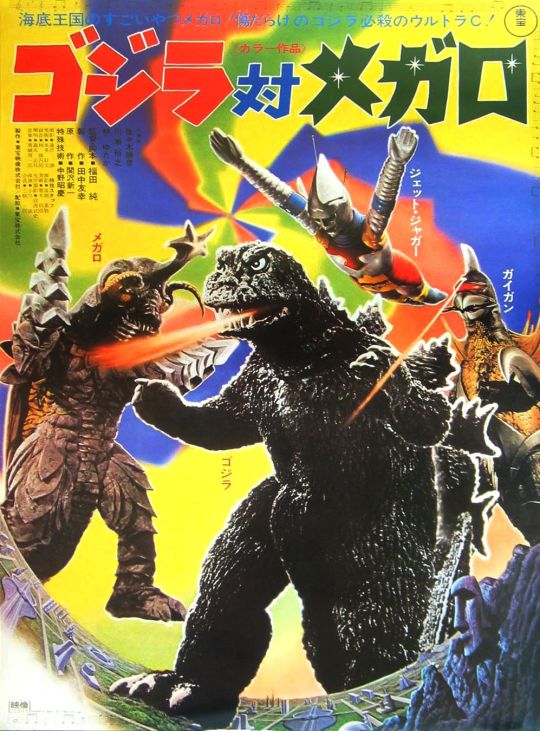
As a blog where I talk about tokusatsu, it makes sense that at some point, I would talk about the very first tokusatsu character ever made: Godzilla, the King of the Monsters.
It's hard to really describe the impact this character has had, not just on tokusatsu, but on pop culture as a whole. Even if you haven't seen any of the movies, chances are you've at least seen something referencing or inspired by Godzilla.
But in case you decided to check out this blog while never learning anything about the franchise when it's one of the longest running film franchises of all time, allow me to give a brief recap on the history of Godzilla. The original 1954 film, aptly titled Godzilla, focused on a prehistoric water-dwelling creature who was mutated by an underwater nuclear weapons test, and the creature, now called Godzilla (Played by Haruo Nakajima), goes on a rampage across Tokyo. All attempts to kill Godzilla fail, until one Dr. Daisuke Serizawa (Played by Akihiko Hirata) is forced to reveal a new superweapon he created during his studies of oxygen, the Oxygen Destroyer. Being the only weapon more horrifying than nuclear weapons, it does its job and kills Godzilla, though Dr. Serizawa kills himself while unleashing the Oxygen Destroyer so it can never be made by anyone else.
Of course, in the sequel, Godzilla Raids Again, another Godzilla was discovered, and now humanity had to find a way to deal with him without the Oxygen Destroyer. Godzilla fought several monsters during the next few movies, like Anguirus, King Kong (yes, seriously), and Mothra, before he started to develop into more of a hero, fighting antagonistic monsters like King Ghidorah, Hedorah, and Gigan.
This was more due to the fact that Godzilla had started to build up a following among children, so in the late 60s and early 70s, the movies started to take on a lighter tone to better appeal to younger audiences. This time isn't seen in a good light by Godzilla fans, as in addition to the writing quality going down thanks to none of the darker themes the earlier movies had, the budget also suffered thanks to a combination of problems with the Japanese economy and television doing a number on the movie industry. To many, Godzilla vs. Megalon would be seen as an amalgamation of all the problems people had with Godzilla movies at the time, with the poorly written story and cheap production value.
Godzilla vs. Megalon only took three weeks to film, employed a lot of stock footage, and had one of the most ludicrous stories in the entire franchise. As a result, the film didn't do so well at the Japanese box office, but in America, it's a different story.
In 1976, film distributor Cinema Shares re-released Godzilla vs. Megalon for American audiences, and put a lot of effort into marketing it. The main promotional poster took influence from the one used for the remake of King Kong that would come out later that year, which featured Kong standing on top of the World Trade Center.
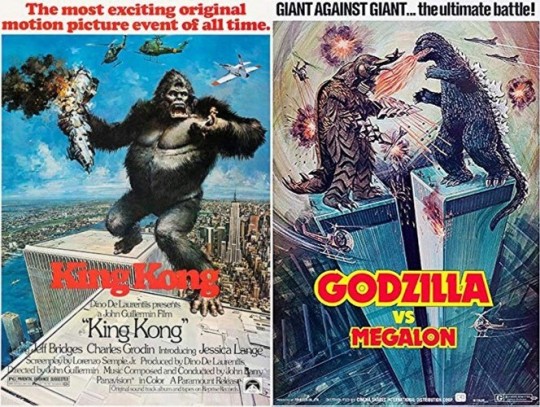
Of course, even though the whole point of that poster was to show that this was a more modern take on the story of King Kong, and it would play into the climax of the remake, Godzilla never goes near New York during his latest movie. Of course, it didn't matter, because the hype surrounding the King Kong remake was so big, many argue it contributed to its success at the box office. For comparison, Godzilla vs. Megalon only earned about ¥220,000,000 in Japan (while I can't measure how much it meant back then, it was only around $1,665,246), in America, it earned $20,000,000.
However, the hype didn't stop there. Godzilla vs. Megalonalso gained a second life through TV broadcasts, being the first movie in the franchise to get a primetime airing on March 15th, 1977. Not only was the film cut down to about 48 minutes to fill an hour-long timeslot with commercials, but it featured famous comedian John Belushi dressing up in a Godzilla suit for the ad bumpers. Unfortunately, because this was before home recordings became mainstream, said bumpers are now considered lost media. Another major source of “publicity” for the movie came in the form of being the first of two Godzilla movies to be featured on Mystery Science Theater 3000, with one of the most infamous scenes in the movie being shown in the opening for the next few seasons.
It's because of all the airtime Godzilla vs. Megalon got in America that many people are under the assumption that Godzilla is a franchise with nothing more than goofy monster fights. Remember, this was before stuff like streaming services and the internet made it easier for people to watch Godzilla movies, so TV airings were everything back in the 70's. Since then, more people are aware of the Godzilla franchise being of a higher quality and don't look back fondly on this movie.
But how has it held up after almost fifty years? Let's find out as we take a look at Godzilla vs. Megalon
The movie opens with a nuclear weapon test being conducted on the Aleutian Islands, one that was so powerful, it affects Monster Island, the home of most of Earth's giant monsters like Godzilla (Played by Shinji Takagi), Rodan, Anguirus... or rather, stock footage of them, as the damage done to the island is done reusing footage from Ebirah, Horror of the Deep and Destroy All Monsters. Like I said earlier, a movie with a shoestring budget like this had to rely on a lot of stock footage. The only real original footage in this scene is to show off the new Godzilla suit.
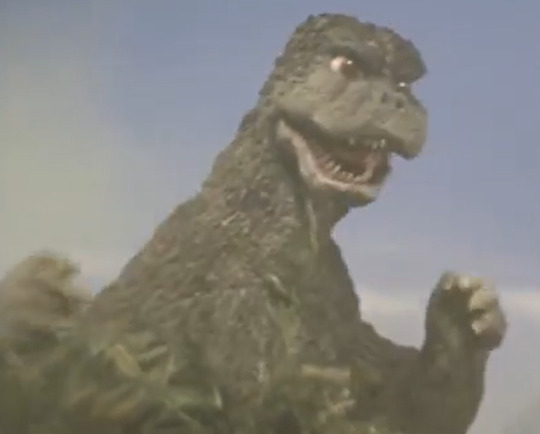
And boy, is it bad. Not only are the dorsal fins less pronounced, but they gave the King of the Monsters these big googly eyes to make him appear less threatening, and he just looks ridiculous. His body language also makes him look more like a cartoon character than a fierce monster, as we'll see later on.
As Monster Island is slowly torn apart by the explosions, we get the opening credits. And I hope you enjoyed that minute of Godzilla in the prologue, because he doesn't appear for another 46 minutes in this 80-minute long movie. And if you thought that because Anguirus and Rodan would appear past this opening, think again, buster.
We then cut to our human characters for the movie, Goro (Played by Katsuhiko Sasaki), his younger brother Rokuro (Played by Hiroyuki Kawase), and their friend Hiroshi (Played by Yutaka Hayashi). Their picnic is ruined when the lake they were trying to relax at is suddenly drained. Goro and Hiroshi barely save Rokuro (who was riding a boat at the time) from being sucked into the whirlpool thanks to one a rope gun Goro invented.

Because I guess in his spare time, he makes stuff for Batman.
On the drive back, Goro, Hiroshi, and Rokuro talk about the recent nuclear testing and the potential damage it could do to humanity in a scene that calls back to some of the themes in the earlier Godzilla movies.
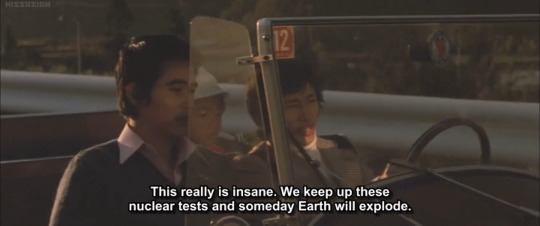
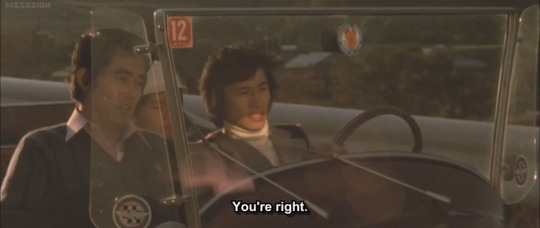
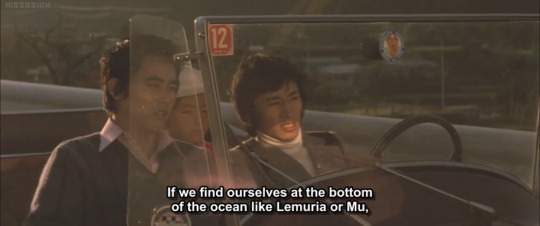

Of course, this exchange goes nowhere, and is only here to foreshadow the origins of the villains for the movie. So, thanks for nothing, writers.
The three get back to Goro's house, they find two people (Played by Kotaro Tomita and Ulf Otsuki) have broken into it. The burglars escape, but during the skirmish, Hiroshi manages to nab a button off one of their suits, which is the same color as some mysterious red sand. The next day, not only does Goro have the results of the tests he ran on the red sand, he also finished a little personal project of his.
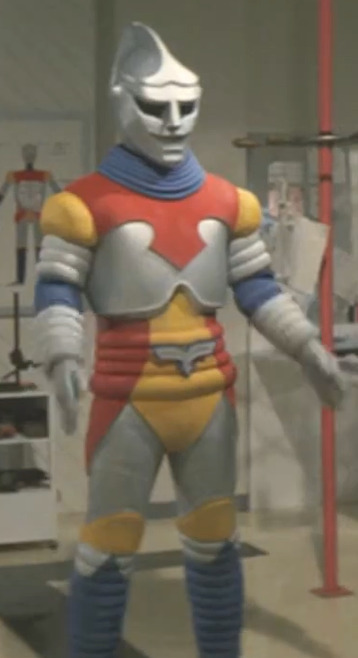
This is who many Godzilla fans consider to be the true hero of the movie, Jet Jaguar (Played by Tsugutoshi Komada most of the time and Masachika Mori in some scenes), and he has a pretty interesting backstory. In late 1971, Toho and Tsuburaya Productions both sponsored a contest held by Japanese supermarket chain Seiyu, where kids could submit their own designs for a new monster, and the winner's creation would be featured in the next Godzilla movie. The winning design would be one Masaaki Sano's Red Alone, and when he first saw the suit made for his creation during an appearance on the TV show, Katsura Kokinji Afternoon Show. Sano wasn't happy with how the design was changed from his submission.

And then, as you can see from the picture above, Toho tweaked the suit even more until it resembled a bootleg Ultraman. I'm not sure what's worse, the kid who got screwed over by the people who held the contest he won fair and square, or Eiji Tsuburaya's family who had to see his work ripped off not even three years after his death.
Anyway, not long after Goro shows off the newly built Jet Jaguar to Hiroshi, the two thugs from earlier break in again, knock out Goro, Hiroshi, and Rokuro, and it's revealed that the home invaders are from the underwater kingdom of Seatopia, though you'd be forgiven if you assumed it was a weird college fraternity. Their Emperor (Played by Robert Dunham) explains his reason for declaring war on humanity.
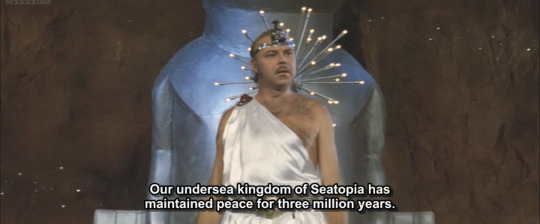

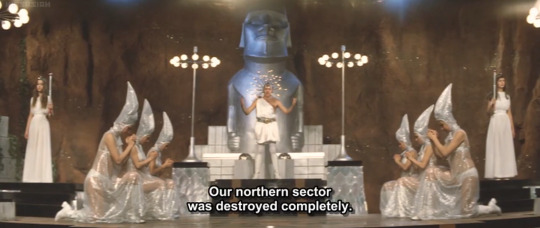
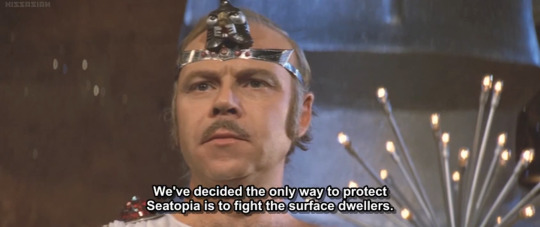
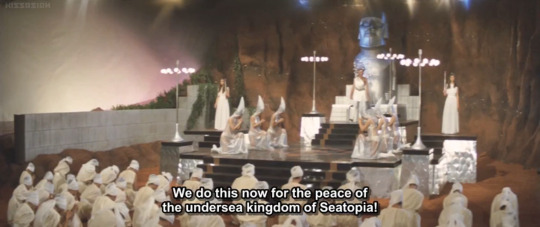
Okay, so basically, rather than simply tell the leaders of humanity, “Hey, stop blowing up our home”, the Emperor's plan is to just fight back with little room for argument. See what I mean when that nuclear testing conversation from earlier went absolutely nowhere? It's only mentioned to explain why the Seatopians are pissed at humanity, but their plan is to be just as reckless as the nuclear tests humans are conducting in the first place. And even then, I'm pretty sure their plan is more dangerous than controlled nuclear tests.
What's their plan, you might ask? It's to have their ancient god, Megalon (Played by Hideo Date), attack humanity. What does this have to do with breaking into some rando's home? Well, for some reason, they need Jet Jaguar to act like a seeing eye dog for Megalon and guide him to wherever the Seatopians want him to go. Because it's not like they could have just stolen a helicopter or something like that instead of a highly experimental robot, right? Hopefully, you're starting to see why so many people have problems with this movie's story.
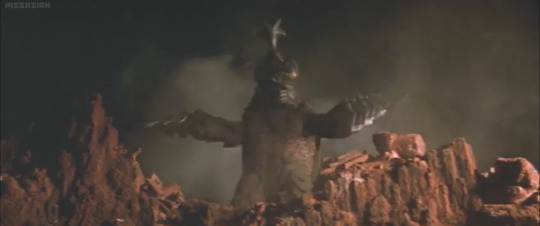
Of course, for all the faults surrounding this movie, I will admit Megalon has a pretty impressive design. I really like the insect motif, and the horn and claws make him stand out from other monsters, even Gigan. I'm honestly surprised more people don't talk about how similar he is to Mothra though. Seriously, he's an insect-themed monster worshiped by an ancient civilization of humans to the point where they even have their own ritual to summon him. It's like the Seatopians worship Mothra's deadbeat older brother.
Goro and Rokuro are kidnapped and tied up in the back of a truck while Hiroshi is tied up back the house. Why they aren't just killed is anyone's guess, but then Hiroshi wouldn't learn more about the Seatopians from the man holding him hostage before he escapes. Hiroshi gets to his car and drives off, but gets into a pretty mediocre chase scene with some other Seatopians. When they're not driving at regular speed on an open road, they're gingerly driving over some stairs in a park or forest. It only gets kind of exciting towards the end where they go off-road and drive towards a construction site with a lot of bumps. Hiroshi outsmarts his pursuers and even gets one of them drenched in wet cement. And yes, they even play the “wah-wah-wah-wahhh~” sound effect for this.
After Goro and Rokuro are freed from the box falling off the truck (and someone aren't injured in the process), Megalon attacks Japan in one of the movie's worst scenes. While I understand the need to reuse certain footage, the way stock footage from older movies is used here is just way too obvious. Not only does it not match up with the cinematography of this movie since a lot of this footage is almost a decade old, even when some of the reused effects for the Maser Cannons hit Megalon, the beams aren't even the same color.

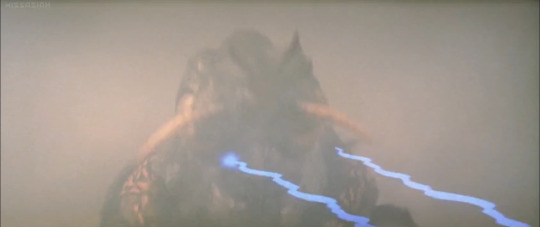
It's like the people behind this movie saw the earlier scene where Megalon breaks a dam, which was very impressive visually, and just thought that was the only miniature they could afford to build and break. And this isn't even getting into the later scene where Megalon swats some jets out of the sky, and you can clearly see Gigan's claw in some of the shots. Hell, I'm pretty sure that was possibly the same shot used multiple times.
Speaking of which, after Goro regains control of Jet Jaguar and orders him to find Godzilla and ask for help, the Seatopians, despite being an underground civilization that hasn't been able to contact humanity, is able to contact the M Space Hunter Nebula Aliens from Godzilla vs. Gigan and ask if they can borrow Gigan. Again, do you see why this plot doesn't make a lot of sense? If they could contact aliens, why couldn't they contact the humans instead?
Hiroshi and Rokuro break back into their house and take out the Seatopian stationed there right before they reunite with Goro. While Godzilla is still on his way, Jet Jaguar moves on his own despite not being ordered to and goes to fight Megalon, growing in size to do so. How did Jet Jaguar do this?
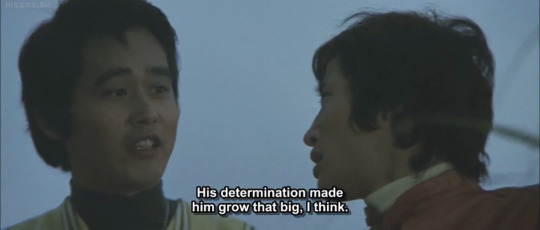
youtube
Surprisingly, the English dub is even weirder and says “He programmed himself in some way to increase his own size”. Look, it was the 70's, and we were still learning how computers worked, okay?
Of course, determination can only get you so far, as Jet Jaguar finds out once Gigan teams up with Megalon. Since Jet Jaguar is fighting against a cyborg supersoldier and a literal god while has no weapons to defend himself with, he naturally gets the tar beat out of him. Thankfully, Godzilla arrives, and the final battle begins.
Of course, like a lot of the action in this movie, it's nothing special. There's a lot of reused footage (especially from Godzilla vs. Gigan), and the choreography isn't the best. Like I said earlier, this movie helped add to the misconception that monster movies are nothing more than kids' stuff, and the wacky pro wrestling action doesn't help disprove either. Of course, both sides still get some decent moments, like when Jet Jaguar throws Gigan up in the air for Godzilla to use his atomic breath on.
But of course, I'm forgetting about one of the most infamous moments in Godzilla history. Ladies and gentlemen, I present to you... the Godzilla Kick.
youtube
Yes. This really happened. I don't know if I should comment on the position that his body took on during the kick, why Godzilla did it twice, or the fact that this is basically a repeat of Anguirus slamming his spiked back into King Ghidorah in Godzilla vs. Gigan.
Of course, after some more pummeling, Megalon retreats, and the Seatopians decide to seal off their civilization once again. Godzilla and Jet Jaguar say their goodbyes, and our movie ends with Goro, Hiroshi, and Rokuro heading home, all while the memorable Jet Jaguar theme plays.
As a whole, this movie was pretty dull. Not much really happened that was worth mentioning, especially compared to some of the weirder movies like Godzilla vs. Hedorah or Godzilla vs. Gigan, which had some weirder visuals and action scenes. The plot was pretty barebones, the villains were almost nonexistant, and the action was very underwhelming.
So why is this movie so despised by Godzilla fans? While it's nowhere near as bad as the 1998 Godzilla movie, or the anime trilogy, this movie still embodies a lot of problems the Godzilla movies had during the late 60's and early 70's. It was too campy, the effects were cheap, it reused way too much footage, and the whole invasion conflict was just overdone at this point. Thankfully, the next two movies, Godzilla vs. Mechagodzilla and Terror of Mechagodzilla would be seen as a return to form by fans, and are a much better way to close out the Showa Era.
Of course, nowadays, this movie has a bit of a cult following as a “So bad, it's good” experience. It can be goofy at times, and it can make for a good viewing experience if you're in the mood to laugh (Just ask Joel and the Bots). It helps that like I mentioned earlier, there are worse Godzilla movies with even more flaws than just being really silly. Even Godzilla fans have warmed up to Jet Jaguar as a character, to the point where he would have a major role in the 2021 anime miniseries, Godzilla: Singular Point.
As a whole, I guess if you're in the mood to see Godzilla at his goofiest, or at the very least, see how weird Godzilla movies could get towards the end of the Showa Era, I'd give it a watch.
4 notes
·
View notes
Text
Crimson Ace Reviews: Ultraman (1966), the Start of a Legend
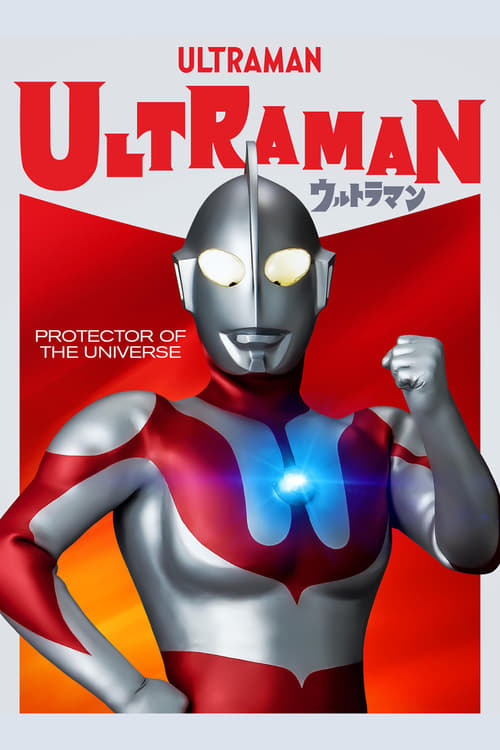
For my first review, I took a look at the first tokusatsu series I ever saw, and today, I'm going to take a look at arguably the first tokusatsu series anyone ever saw, if not the most popular (apologies to any Nanairo Kamen fans reading this). But before we dive into this cosmic tale, I should probably explain the importance of another show to new readers looking to get into tokusatsu, as well as the man behind it, Eiji Tsuburaya.
Born on July 7th, 1901, Eiji Tsuburaya is considered by many to be the Father of Tokusatsu. This is a man who has been involved in the production of movies since he was eighteen years old, starting off as an assistant cameraman as he gradually started to pioneer new special effects in his craft. After working on countless war propaganda films for Japan's military during World War II (with the effects in one film in particular, Hawai Mare Oki Kaisen, being so convincing, it is said that General Douglas MacArthur assumed the movie had actual footage of the attack on Pearl Harbor), Tsuburaya teamed up with Ishiro Honda and Tomoyuki Tanaka to work on a little indie film involving a character with a very minor presence among several of Japan's historical cultural icons. You might know it better as Godzilla.
While it initially got mixed reviews from critics at the time due to touching on the impact the atomic bomb had on Japanese society only nine years after the bombings of Hiroshima and Nagasaki, over time, Godzilla became a hit, so obviously, more sequels were commissioned, and Tsuburaya was involved in the filming of more movies. Rodan? Mothra? King Ghidorah? Eiji Tsuburaya might not have been the sole creator of these characters, but it's thanks to his talent that these iconic monsters made to the big screen in the first place.
By the early 1960's, Tsuburaya had clearly made a name for himself, but he wanted to focus more on a project of his own. Something that wouldn't just be credited as a project he did the special effects for. With television growing in popularity at the time, Tsuburaya set his eyes on making it to the small screen. In particular, he was inspired by American anthology shows like The Twilight Zone and The Outer Limits. And of course, that show eventually became known as... Ultra Q. What, you thought I was going to mention a different show?
Similar to The Twilight Zone, Ultra Q (named after a popular phrase at the time, “Ultra C”) would focus more on a group of scientists investigating supernatural phenomena more often than not caused by giant monsters or aliens, with the occasional exception. The show was a massive hit with audiences, so the Tokyo Broadcasting System, or TBS, wanted a new show like it, only in color. Remember, this was the 60's when color TV wasn't as common as it was now, so seeing broadcasters want Tsuburaya's work to be in color was a big deal. There were a few conditions though, like more focus on monsters, and for there to be a heroic monster on humanity's side like what Godzilla had become at the time.
In spite of those requests, the show I'm actually here to talk about premiered on July 17th, 1966, and essentially kicked off a long line of tokusatsu heroes on the small screen. But how does this show hold up more than fifty-five years later? Well, let's find out as we take a look at the original Ultraman
THE STORY
The Science Special Search Party (SSSP) is a government organization dedicated to investigating scientific anomalies and protecting Earth from invading aliens and giant monsters. One night, Shin Hayata (Played by Susumu Kurobe), is sent to investigate a mysterious blue sphere landing in a nearby lake, only to accidentally collide with a red sphere. Inside the red sphere is an alien from Nebula M78, who feels remorseful for accidentally killing Hayata, so to make up for the cosmic vehicular manslaughter, he offers to give his life to save Hayata. The two merge, and when the situation calls for it, Hayata is now able to use a device called the Beta Capsule to transform into the alien to fight giant monsters other and aliens head on with his energy attacks, calling himself Ultraman (Played by Bin Furuya).
Of course, Hayata isn't alone on his quest to defend the Earth from danger. In addition to himself, the SSSP consists of Captain Toshio Muramatsu (Played by Akiji Kobayashi), a very serious, yet fatherly leader to the team who stays cool in a crisis, Mitsuhiro Ide (Played by Masanari Nihei), a bumbling inventor who helps develop the technology needed to deal with whatever threat they face, Daisuke Arashi (Played by Sandayu Dokumamushi), an expert marksman with a bit of an itchy trigger finger, and Akiko Fuji (Played by Hiroko Sakurai), the primary communications officer and sole female officer who isn't afraid to speak her mind. They're later joined by Isamu Hoshino (Played by Akihide Tsuzawa), a child who tags along with the team, before he is eventually made a full-fledged member himself.
Seeing how this was a TV show in the 1960's, there's obviously no major shifts in the status quo or the character dynamics. It's just a very simply formula: The SSSP is called in to investigate a weird occurrence, they spend time figuring out what's behind it, it turns out to be an alien or giant monster, they try their hardest to engage the threat once the situation escalates, Hayata conveniently manages to duck out so he can transform into Ultraman and save the day when all seems lost. There's nothing wrong with this necessarily, seeing how this was before TV shows became more serialized. In the modern age of streaming and YouTube, this kind of formula also makes watching shows like this easier for newcomers, as watching every episode isn't a requirement thanks to how interchangeable they can be.
At the same time, it also makes marathoning the show a bit confusing, with how inconsistent the characters can be. While there are decent focus episodes for characters like Ide and Arashi, the development rarely sticks. Arashi in particular suffers from this, as in one episode, “Don't Shoot, Arashi”, he learns about how dangerous his trigger-happy nature can be, but two episodes later? He goes against orders and tries to shoot a giant monster. While it's not too bothersome, it is still important to note, as it doesn't really hamper your enjoyment of this show.
Generally, the tone of these episodes can vary. While there's still a giant monster for Ultraman to fight every episode, there's almost always something interesting to shake things up. To list a few examples, “The Coast Guard Command” features a subplot about some kids uncovering a diamond smuggling scheme, “The Rascal from Outer Space” is more lighthearted in tone with how the monster of the week is created from a wishing stone, “Brother from Another Planet” was more of a conspiracy episode with the alien invader's plan to trick the SSSP into appearing benevolent, and “Phantom of the Snow Mountains” has a supernatural mystery element to it revolving around this little girl. You never know what kind of episode you're going to get with this show, and I think it makes sense when you remember this was a follow up to Tsuburaya's take on The Twilight Zone.
THE HEROES
Once again, because this would serve as the basis for countless tokusatsu shows after it, Ultraman has a fairly basic cast of characters, but they're not exactly boring. The actors all do a good job with that they're given, and they play off each other nicely.

Hayata is a... pretty decent lead. Much like a lot of main characters in the 60s, there's not really a lot of character development on his part. He's meant to be this paragon to look up to, this heroic figure meant to inspire others. It's something the show focuses on more by trying something that future installments wouldn't really do: Make Hayata the second in command of the team. Normally, Hayata is the one the others report to when Captain Muramatsu isn't around, and generally has more of a commanding presence compared to later main characters, who are usually portrayed as everymen with more flaws. At the same time, he'll do what he can to help the others when they have problems to deal with, almost like a big brother.
Even compared to the others who have their own flaws like Arashi's temper, Ide's immaturity, Hayata doesn't show a lot of vulnerability, at least, in the sense of character flaws. Yeah, he gets in trouble and there are times where he can't transform into Ultraman to save the day, it's usually not done to test Hayata's resolve or set up an interesting conflict. It's just done to explain why Ultraman can't stop the bad guy of the week. The few times Hayata isn't able to transform into Ultraman, it's normally resolved by circumstances outside of his control, like when he lost the Beta Capsule in the two-part episode, “The Prince of Monsters”, he didn't even know he lost it until some kid gave it back to him, robbing us of a conflict where Hayata tries to stop a monster without Ultraman's powers.
In general, the show also kind of glosses over what happened to Hayata in the first episode. The whole thing with him merging with an alien is rarely touched on, and it's never made clear if any of Hayata's actions were influenced by Ultraman, especially when the final episode shows he can still talk. What, was Ultraman just sleeping whenever Hayata didn't need to use his powers?
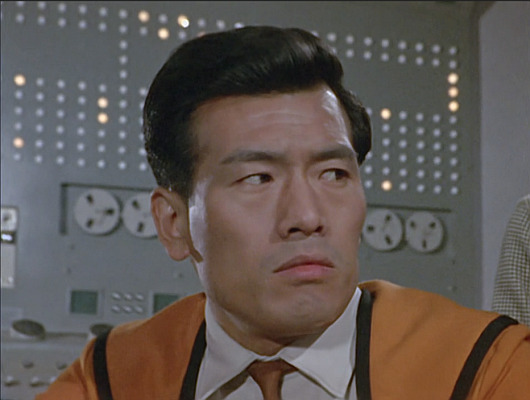
Captain Muramatsu is meant to be the more reasonable person in the SSSP, which makes sense, given that he's their boss and all. He's usually the least likely to suggest violence as a first option, best shown in the second episode, “Shoot the Invaders!”, where he opposed the Japanese government's idea to try using a nuclear missile against a bunch of alien invaders whose motives they don't even know yet. He's generally one to act more like a father to the team, and compared to the others, doesn't have any quirks. He makes for a decent straight man for the show.
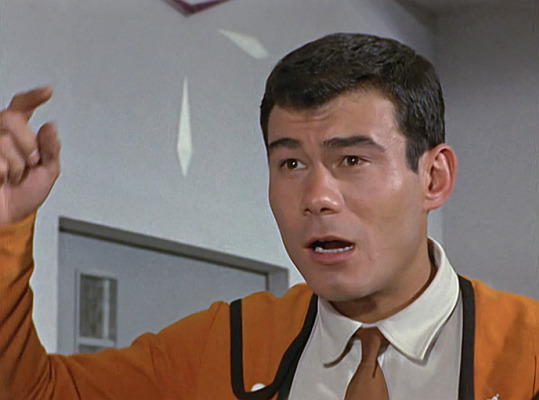
I don't think it's really controversial to say Ide is my favorite character in the show, and for multiple reasons. Masanari Nihei is clearly having a ball in this role, and gives the best performance out of the entire cast. Ide's antics lead to some pretty funny moments, and for a comic relief character, he's not as annoying as you would think. He has his moments where he likes to prop himself up as this genius in order to boost his ego, but is usually subjected to some form of slapstick.
At the same time, there have been a couple of episodes that show another side to Ide's character, like “My Home is Earth”, where he hesitates to fight a monster that used to be a human, or “The Little Hero”, which shows him doubting the effectiveness of his inventions when Ultraman is usually the one to save the day. I'd argue of the entire SSSP, Ide is the one with the strongest resolve, as he always tries to come up with new weapons and gadgets for the team to use to save the day, and more often than not, they come in handy with it comes to dealing with whatever the SSSP is struggling to beat.
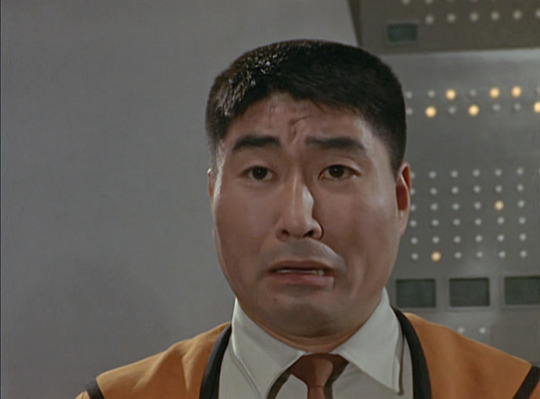
Arashi is honestly the most boring member of the main cast in my opinion. He's usually the most bullheaded of the SSSP, itching to get into a fight and shoot whatever threat the team is facing. At the same time, he does get some moments where he helps put the clues together when the team is trying to understand the monster of the week's powers and MO. He still gets the least amount of focus and moments to shine compared to the others, and compared to Ide's comedic moments, Arashi's trigger-happy nature gets a little annoying after a while.

For being the only female lead in a TV show that aired during the 1960's, Fuji is a surprisingly strong character. Yeah, she gets kidnapped and endangered a lot, and yeah, she's normally the one to man the communications center for the SSSP, but at the same time, she's not really shown to be an idiot, and can be just as clever as the others. In the very first episode, when Ide said that she was “still a girl” despite being part of the SSSP, she immediately fired back, showing she isn't one to be teased. She also has a tendency to tease the others and mess with them a little, like in “Five Seconds Before the Explosion”, where she claims to be going to a resort with someone for her day off, only to reveal it was Hoshino she was going with. While she's not a total snarker on the level of Lois Lane, she still has a lot of spunk that prevents her from just being “the girl” of the team.
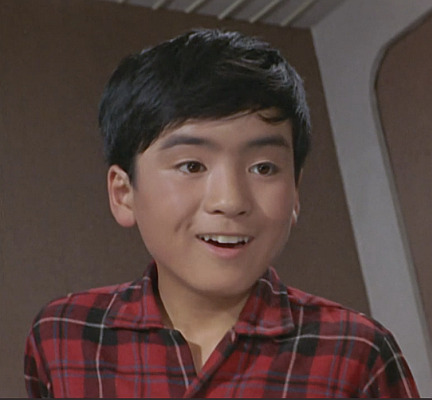
Hoshino is arguably the only member of the SSSP who goes through an arc in this show. He starts off as a very reckless kid who stole Arashi's gun to fight a giant monster himself, but throughout his appearances, he's shown to grow as a person and take things more seriously, making his official welcome into the SSSP feel natural. Unfortunately, he wasn't able to stay for long, as Akihide Tsuzawa had broken his leg on a skiing trip, so he went the way of Chuck Cunningham.
Overall, while the cast is seen as basic by today's standards, they're still enjoyable enough on their own.
THEIR ARSENAL
Hayata's Beta Capsule is a very simple transformation device by modern standards. There's no trinket he needs to insert, and there's no jingle that plays when he transforms. Hayata just presses the button, and boom, he's Ultraman. It's honestly kind of funny to look back on this when you know how toyetic tokusatsu shows can get. Hell, compared to the other transformation devices of the Showa Era, this is somehow the most complex with it being a piece of technology, as opposed to the rest (Sans Ultraman 80's Bright Stick) being fashion accessories like sunglasses, badges, and rings.

Ultraman's suit, designed by Toru “Tohl” Narita, went through three designs throughout the show's 39-episode run. There were a few complications that led to the cheaper looking suit used for the show's first third, mainly the plan to originally make Ultraman's mouth move before it was scrapped. The next two suits would give Ultraman a much sleeker look and a shinier color scheme that would better fit the iconic design of the character that is still used to this day. Compared to most of the monsters we've seen in Tsuburaya's earlier works, this is a suit that really screams “alien”, yet it has a look that makes it appear benevolent.
Ultraman's fighting style really helps him stand out from Tsuburaya's other creations, as unlike Godzilla or Rodan, Ultraman's attacks aren't really fierce. They're more coordinated and he isn't as destructive as someone like Godzilla is. In combat, Ultraman specializes in wrestling with his opponents, tending to find a way to exhaust them into a state where they're vulnerable to his energy attacks. The Specium Ray is Ultraman's signature attack, and it's really cool, being a simple energy ray fired through his iconic pose.
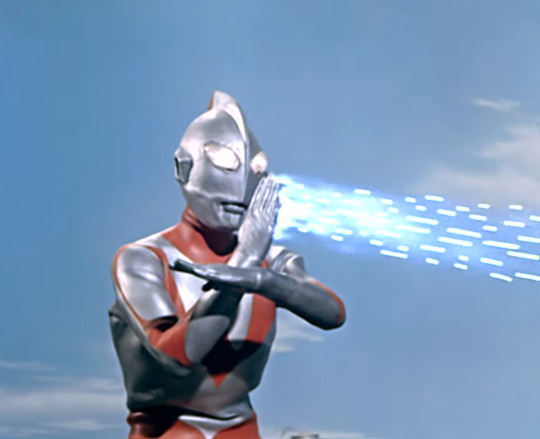
Be honest, if you're an Ultraman fan, you've most likely made a hand gesture like this before. I'm sorry, but I don't make the rules.
Ultraman's other primary attack is the Ultra Slash, where he creates a sharp energy blade to slice up his enemies with.

Both of these attacks have essentially become synonymous with the franchise, much like how the Rider Kick has become synonymous with the Kamen Rider franchise.
On the other hand, there's the other powers you don't really hear about when talking about Ultraman, though I call them the “We only have two minutes to wrap up the episode, so let's have Ultraman do whatever the plot needs him to do” powers. He has X-ray vision, laser eyes, the ability to shoot water from his hands, the ability to spin at high speed, and in one case, somehow turn a monster into a constellation for reasons that are way too confusing to explain. And I'm sure I missed some powers that even the Ultraman Wiki doesn't know about.
Of course, with all of these powers, you'd think there wouldn't be a lot of tension in the story. You would be right, and a lot of the producers realized this, so they gave Ultraman another one of his defining features: The Color Timer. Whenever Ultraman is struggling in a battle, or if he starts to run out of solar energy thanks to our sun not having enough light to power him, the Color Timer, a blue emblem in the middle of his chest, will start to blink and let off a beeping sound, sort of like a video game. If the Color Timer goes out, Ultraman will lose the power to ever stand up again. If you forget, don't worry, because the narrator reminds the audience of this nearly every episode, with a handful of exceptions. This is a great way to add stakes to the conflict, as the Color Timer going off can punctuate how much of a struggle this is for Ultraman.

The SSSP has some pretty cool suits. I really love how they switch from the blue suits to the more combat-oriented orange battle gear. It's such a 60's spy show thing, and I love it. The helmets also go really well with the suits. Their badges are also a unique way of communication, and it shows how advanced their technology is.
The SSSP has a very basic arsenal. The Super Gun is their primary firearm, shooting lasers capable of harming monsters. Arashi in particular gets the Spider Shot, a bigger gun more power. Another gun that sees use is the Mars 133, a rifle with more power than the Super Gun. There are also other guns and inventions made for the SSSP to use thanks to Ide, but like some of Ultraman's powers, they're usually situational.
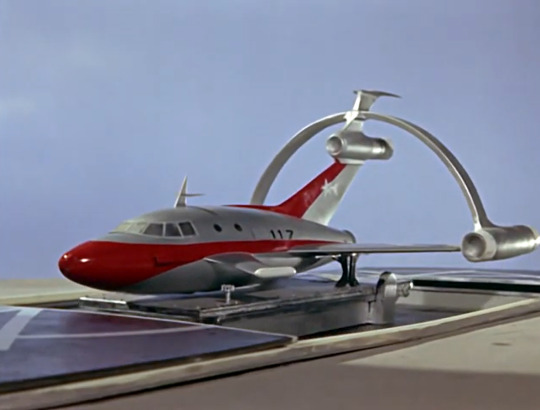
Their primary vehicle is the Jet VTOL, a fighter jet that can travel to space when equipped with a special engine. A simple plane, but nothing short of iconic. And again, while there are other vehicles, they don't see as much action.
While the arsenal seems very barebones for a tokusatsu show, it doesn't really stop the SSSP from doing their job really well. In general, the SSSP gets a surprising amount of kills to their name. Not only do they manage to take out about ten monsters/aliens with standard SSSP weaponry, seven giant and three human-sized threats. I want to emphasize the “about”, because a lot of episodes focus on the SSSP's attempts to stop the monster of the week, and while Ultraman typically gets a lot of the kill shots, there are plenty of monsters that are already weakened as a result of the SSSP's tactics. Generally, despite being the character the show is named after, Ultraman is usually used as a last resort. Even though they're the first attack team in Ultraman history, the SSSP's arsenal arguably makes them one of the most effective in the franchise.
THE VILLAINS

Monsters in the Ultraman franchise are very different from other tokusatsu shows. Rather than a comical monster of the week who works for a greater evil, most monsters in the franchise, especially the Showa era, are standalone threats for the heroes to take care of. Usually, they tend to either be alien invaders seeking to conquer the Earth, or monsters that the humans accidentally woke up and/or pissed off. Like I said, the twist usually comes from the other element thrown into the plot of every episode.
While it's a bit of an oversimplification, there are still a lot of creative monsters and aliens here still have quirks and abilities that make them stand out from each other for the most part. You have Baltan, an insect-themed alien with teleportation abilities, Neronga, an ancient monster with the power to consume electricity to make himself invisible, Zarab, an alien who can disguise himself as an evil version of Ultraman, Dada, an alien who tries to abduct humans as test subjects with the help of his shrink ray, Keronia, an member of a race of mutated plant monsters who tries to enslave humans for their blood, and Mefilas, an alien who tries to conquer the Earth with trickery rather than brute force. And I haven't even gotten to the other monsters in my highlights list, who are just as creative.
Of course, there are still two other monsters I want to talk about here, the first of them being arguably the most iconic monster in the franchise, Gomora. Gomora was one of the first monsters to actually give Ultraman a challenge, and was the star of the franchise's first two-part episode. Since then, he's gotten a lot of focus in later installments as a more heroic monster. When you see all the forms and powers Gomora has gotten over the years, it's kind of funny to see Gomora beat Ultraman in a fight with nothing but his brute strength and long tail. Here, he's just a giant dinosaur who was pissed he was woken up from his nap and kidnapped like King Kong, yet he still managed to overwhelm Ultraman. It's like watching a wild coyote get the better of Superman.
The other monster I want to talk about is infamous, not because of the episode it came from, but rather, how he looks.

This is Jirass, and yes, that is an old Godzilla suit. Well, technically the head of the one used in Invasion of Astro Monster and the body of the one from Mothra vs. Godzilla. The thing is that most of the monster suits were reused from the Godzilla movies thanks to Toho letting Tsuburaya's production team borrow them for this show. While there's actually a lot of reused suits, this is the one people tend to talk about the most, and for obvious reasons.
For the most part, in spite of a lot of them being reused from older suits, the monster designs really hold up today. A good example of how versatile the suits are is the Baragon suit from Frankenstein vs. Baragon. It was reused to make three different monsters during the first nine episodes (Neronga, Magular, and Gabora), and they all look visually distinct from one another. There were a lot of times where I was genuinely surprised to learn some of the more memorable monsters in this show were reused from older monster suits. The effects work is that well-done.
HIGHLIGHTS
As a whole, Ultraman had a lot of great episodes, and it was hard to find the ones I thought were outright bad. Most of the “worst” ones were more boring than anything else. The fact that I struggled to find five bad episodes is a good sign of this show's quality.
Top Five Worst Episodes
#5: Secret of the Miloganda
Several botanists are being killed by a mysterious plant creature, one by one, so the SSSP is called to investigate before anyone else can be hurt.
This episode isn't really bad, just slow. The plot is more of a mystery than your standard monster of the week plot, with several scientists recalling their side of the story, and there's some decent buildup to it. The problem just lies in how underwhelming the monster and climax is. The killer, a mutated plant called Greenmons grows giant out of nowhere after seemingly being killed, and the suit just looks so cheap.

Be honest, is this really what you think of when you hear “mutant plant monster”? A moldy oven mitt? All Greenmons does is spray stuff from the hole on its... I want to say face, and move around the one arm it has. This is what you do with a killer plant? Make it a giant can of Lysol? Even the death is underwhelming. All Ultraman does is shoot it with a Specium Ray, and it just catches fire. You can really tell this episode was when the writers and costume designers were still experimenting with new ideas, because it really doesn't hold up.
A later episode, “Who Goes There?”, would do a much better job with the idea of a plant monster in the form of Keronia, and would do so with a much better horror element to it. I'd watch that episode instead of this one. Again, this one isn't bad, just underwhelming.
#4: The Endless Counterattack
While Hayata escorts Indian SSSP member Patty around Japan for her vacation, Zambolar, a monster with control over fire starts to rampage through nearby construction sites, so it's up to the SSSP to take him down.
Compared to most monster of the week plots, this one is pretty boring, and Zambolar himself is a very underwhelming monster. The writers try to throw in an environmentalism message by implying he was woken up by some construction, but it's kind of hard to see Zambolar act like this guardian of the environment when most of his screentime is spent burning stuff down. The chemistry between Hayata and Patty was also forgettable. I guess they were trying to set up some kind of romance compared to other girls Hayata has met in this show, but there honestly wasn't much of a reason to include this character in the story.
Again, it's not a terrible episode, just really boring.
#3: Terror on Route 87
The SSSP is called to investigate a strangely glowing mountain, where they encounter a giant bird monster called Hydra. The monster soon sets his sights on the titular Route 87, all while learning about a connection between it and a child who was killed in a car accident on the same route.
This is an episode where you can tell there were good intentions, but the execution was pretty bad. See, during the mid to late 1960's, there was a high number of traffic accidents in Japan, to the point where people called that time the “War on Traffic”, so this episode was meant to serve as social commentary on it. The problem is how the lesson gets across. Okay, so the monster of the week is connected to a boy who was killed in a traffic accident. That could work for a tragic story. What's less tragic is how the moral of the story seems to be in favor of Hydra, in spite of his massive body count.
Yeah, what happened to the kid was tragic, but how does that make Hydra killing more people as a result of that okay? As a matter of fact, why make the giant monster attacking a highway a bird? I don't get why it's sad that children are killed in car accidents, yet the moral seems to downplay the amount of people killed by Hydra (some of them probably being children too).
This is a pretty lousy episode that needed a lot of work.
#2: The Monster Graveyard
While on patrol in space, the SSSP stumbles upon the bodies of several past monsters they've killed in the past, dubbing it the Monster Graveyard. After heading back to Earth, they're followed by the spirit of another fallen monster, Seabozu. Can the SSSP defeat this latest threat, or is there more than meets the eye to this creature?
This is an episode with a really good idea that would be expanded upon in later entries, and to its credit, it manages to have a pretty solid first act. The SSSP feel remorseful for all the monsters they've killed, especially Hayata, and the scene where they hold a memorial service for them is very powerful. Unfortunately, things go downhill once Seabozu enters the picture. Despite saying they feel bad for having to hurt monsters who weren't able to coexist with humanity, the SSSP has no problem shooting at Seabozu, and even after they learn it just wants to go home, they don't really change their method of operation and keep shooting at it.
Seriously, the second half of the episode is pretty much “Maybe this monster wants to go home, so let's find a way to send him back to space... by shooting him with grappling cables and dragging him towards the rocket against his will because he doesn't know what a rocket is”. Do you want to have a more nuanced story or not? It's a really mean-spirited episode disguised as something pretending to be deep.
#1: The Pearl Defense Directive
Gamakujira, this hybrid toad/whale monster, starts eating pearl oysters, driving the prices of pearls up exponentially. Taking this as a declaration of war, Fuji takes on a more active role than usual to save her favorite kind of jewelry with rest of the SSSP.
While most of the episodes in this show are pretty timeless, this is an episode that has definitely shown its age in a few ways. The way Fuji is written reeks of negative stereotypes regarding women. I'm sure there were good intentions, but the way the conflict is handled is just awful. Put aside the fact that this is the third aquatic monster with a craving for a specific item in the past seven episodes (cacao beans for Guesra and oil for Pestar), the only reason why Fuji is upset at Gamakujira isn't because of the potential damage it's doing to the ecosystem or the economy, but just because she loves pearls.
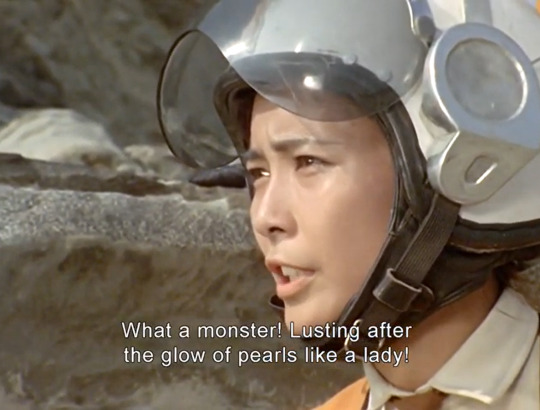
Because, you know, a girl's just got to have her pretty jewelry, right? I feel like if they exaggerated the level of anger Fuji was feeling, it'd be easier to tolerate. Instead, it's like we're supposed to take her anger at her precious pearls completely seriously.
While Gamakujira isn't completely forgettable, it's nowhere near the same level as memorable as other monsters in this show. The goofy tongue and croaking noise it makes is pretty interesting though.
Overall, it's just a terrible episode that's an obvious product of its time.
Top Five Best Episodes
#5: Passport to Infinity
Two meteorites with reality bending abilities are found by a pair of scientists, who each choose to study one individually. One of them comes to the conclusion that if the two meteorites are brought together, bad things will happen... right as the SSSP decided to place them together. After the new meteorite monster, Bullton, is formed, it starts to send the scientists and the rest of the SSSP into the fourth dimension, so they need to try and get out.
For something that aired in 1966, the effects work in this episode is pretty creative here. Yeah, there are some obvious wires and green screen effects here and there, but there are also a lot of clever cuts and camera angles that give the illusion of realty being distorted. Even for being a giant rock, Bullton is an interesting kind of monster. What it lacks in strength, it more than makes up for with its powers.
Yeah, the final battle is kind of weak since we don't get the usual fight choreography on account of Bullton being a rock, the rest of the episode is still a blast, and is a visual highlight for the show.
#4: Present from the Sky
One day, Skydon, a monster randomly that randomly fell from the sky, starts to make its home at a local construction site, and and the SSSP is called to deal with it. There's just one problem: None of their weapons work on it, and it's too heavy for even Ultraman to move. Thus, the SSSP has to employ some more unusual tactics in order to get it off the planet.
We go from one of the trippiest episodes in the show to one of the goofiest episodes of the show. If you're here from my Miraculous Ladybug blog, you'll remember I referenced this episode when talking about “Mr. Pigeon”, an episode featuring a villain with such a wacky idea, you just have to roll along with how weird the action is. I stand by what I said, because this episode is a blast.
The humor in this episode in the form of the SSSP's plans to get rid of Skydon is top-notch. Things just so outlandish, it starts to resemble a Looney Tunes cartoon, and I love it. Just seeing the SSSP continually fail to stop Skydon to the point where one attempt leads to them running away from after shooting it with a rocket is hilarious. The gags that parody the usual Ultraman formula are just so well-timed, and an episode all about stopping a really heavy monster has no right being this funny.
This is easily the funniest episode of the series, and it's also one of the best episodes in the series as a result.
#3: The Lawless Monster Zone
The SSSP is called in to investigate the mysterious disappearance of a research team of scientists on an unexplored island. It turns out that the island in question is swarming with monsters, and after meeting up with the only surviving scientist, what started as a rescue mission turns into a “try not to die before we get the hell out of here” mission.
This is a really nice take on the usual formula of the show. Usually, it's the monster or alien the SSSP stumbles upon that they need to fight off, but this time, they're on a place full of monsters. We have Red King, Pigmon, Magular, and Chandler to deal with. Could there beany more monsters? There's a lot that makes this place a hostile environment, so you wonder how the SSSP will escape.
There's also some cool monsters introduced here too. Aside from Magular and Chandler, we have Red King, a bully who loves to beat up weaker monsters, and Pigmon, a tiny creature who's the one of first benevolent monsters in Ultraman history. These characters both get some good focus and like a lot of the monsters I've talked about, become iconic in later entries.
Overall, it's a really action-packed episode that's a blast to watch.
#2: My Home is Earth
Several planes carrying guests for an international peace conference are being mysteriously shot down by an invisible spaceship. Just when it seems like destroying the spaceship would end the conflict, the pilot of the ship, a giant monster appears. It's soon revealed that the monster was named Jamila, a human astronaut who was mutated into this form after a space flight went wrong. After learning the truth, Ide is left conflicted as to whether Jamila is beyond saving or not as the SSSP is ordered to kill him to cover up the story of what really happened.
Many Ultraman fans consider this to be one of the saddest episodes of the franchise, and for good reasons. The tone is very somber, and it raises questions about whether the SSSP is doing the right thing by trying to put Jamila out of his misery. The fact that Ide isn't the usual bumbling comic relief really says a lot about how serious this episode is, and it makes sense when you remember his inventions are the reason why the SSSP is even able to fight Jamila in the first place.
The cinematography in this episode is gorgeous, some of the best of the show. There's some great uses of lighting and shadows during the dramatic scenes. I especially love this one shot of French SSSP member Alan standing in front of a spotlight while he repeats the orders to kill Jamila while he's obscured by the light, almost like a soulless drone with no empathy for his fellow man.
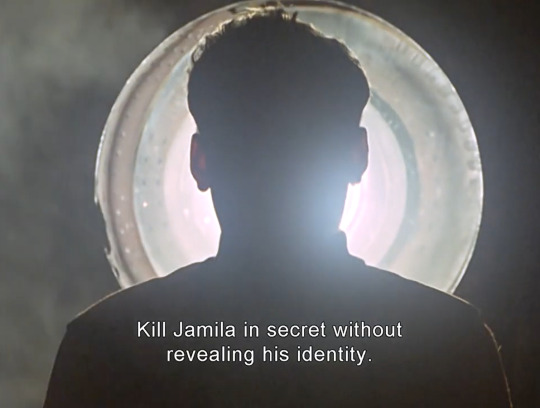
Jamila's story would go on to be one of the most tragic in the franchise's history, and even though it was covered up in-universe, it's unforgettable to us.
#1: Farewell, Ultraman
The SSSP gets word of an invading fleet of aliens who had visited Earth for over forty years, but before they set their sights on humanity, they decide to go after the Japanese branch and Ultraman. As our heroes prepare to fight against near insurmountable odds, it turns out one of the invading aliens disguised himself as one of their allies, and even when it seems like the tide of battle is turning, Ultraman himself has one more challenge that not even he may be able to overcome...
As the final episode of the show, this episode really does a good job to show how high the stakes are. Right from the start, we're dealing with a full-blown alien invasion, from aliens who actually planned ahead instead no less. There's a lot of awesome action, great effects work, and drama from how tense the conflict is.
There's not much else I can say without spoiling anything, seeing how it's the final episode and all, but this one is a must-watch.
FINAL THOUGHTS
Being the first in a long line of tokusatsu TV shows, Ultraman does a lot of amazing things. The effects hold up really well, the characters are very likable, and it introduced a lot of concepts that would endear us to the franchise over fifty-five years later. While it may seem like I don't have as much to say compared to my last two reviews, it's mainly because I'm not sure what else I even have to say.
If you're looking to get into tokusatsu as a whole, please check out this series. It's a classic, and for a damn good reason.
8 notes
·
View notes
Text
Not the Oldest, Just the Best: A Tommy Oliver Retrospective

On November 19th, 2022, Jason David Frank was found dead in Texas, the cause of death being ruled as a suicide. It obviously came as a shock to everyone, 90's kids and tokusatsu fans alike. He was a man of many talents, and he will be sincerely missed.
In addition to his career in the MMA, Jason David Frank was an TV icon back in the 90's, essentially becoming the main character in the original Mighty Morphin' Power Rangers in spite of how limited his role was intended to be. He's reprized his role as Tommy Oliver countless times, has had multiple sets of powers, and is easily the most popular character in the entire Power Rangers franchise, for better or for worse.
But how did he get so popular? What was the appeal of this character that kept us wanting to see him again and again? I say we should take a little walk down memory lane and see how Tommy Oliver went from a pawn in one of Rita Repulsa's deadliest schemes to arguably one of the most iconic characters in tokusatsu history. This is going to be a pretty long retrospective, so I decided to split it up into five parts to make it easier. With that being said, It's Recappin' Time!
(Part 1: Green Up Your Act)
Tommy's first appearance was in the five-part Mighty Morphin' Power Rangers episode, “Green With Evil”, the very first multi-part episode in the franchise. He was introduced as a rival and potential equal to Jason, AKA, the original Red Ranger (Played by Austin St. John). The two's first interaction is during a “martial arts expo”. Yeah, they don't specify what kind of martial arts any of these characters practice, but come on, look at this.

Isn't this some cool martial arts stuff? I dare say it's even an “awesome display of martial arts”, like what the announcer says.
In all seriousness, Tommy was a participant in this expo, and was introduced as the hot new kid in town whose skills were no laughing matter. He went up in a karate sparring match against Jason, and the two were pretty evenly matched. It's a really good way to establish Tommy's prowess, as earlier episodes like “A Pressing Engagement” showed off how strong Jason was on his own. What I like about the first act of this episode is that it doesn't make Tommy too overpowered, since the match ends in a draw. Yeah, Jason was struggling to pull through, but at the same time, it shows that him and Tommy are equal in many ways. It also shows Tommy as a virtuous person, as when resident bullies Bulk and Skull (Played by Paul Schrier and Jason Narvy respectively) start bothering Kimberly, AKA, the original Pink Ranger (Played by Amy Jo Johnson), Tommy steps in and gets them to back off. Even though he seems like a hotshot, he's a good person at heart. Unsurprisingly, Kimberly falls for Tommy partially because of this, and the two make plans to hang out.
Unfortunately, Tommy's prowess in martial arts attracts the attention of the evil Rita Repulsa (Voiced by Barbara Goodson), who chooses him to be his brainwashed servant. After brainwashing Tommy, Rita grants him Ranger powers of his own thanks to having a lost Power Coin, the source of the other five Rangers' powers. Granted, it's never explained how she came into contact with the Coin, but it's hinted that she stole it from the Rangers' mentor, Zordon (Voiced by David Fielding).
Either way, Tommy becomes the Green Ranger, and proceeds to, for lack of a better work, ABSOLUTELY WRECK THE SHIT OUT OF THE OTHER RANGERS. Like, I can't understate how deadly of a threat Tommy was in his first episode alone. As soon as he gets the powers, Tommy breaks into the Rangers' Command Center, and just tears into all the wiring in all the control panels, even infecting Zordon's assistant robot, Alpha 5 (Voiced by Richard Steven Horvitz), with a virus. Not only does this mean that the Rangers' communicators are offline, not only does this prevent them from teleporting to the Command Center and back, but because the technology in the Command Center is needed for Zordon to communicate with the Rangers through his time warp, the Rangers have pretty much lost all of their support. It doesn't help that Tommy manages to beat up all five Rangers with ease, even breaking into their Megazord just to throw them out. And this is all done with his bare hands, before Rita even gives him the Sword of Darkness.
This arc in general gives a lot for the Rangers to do. In addition to Kimberly trying to reach out to Tommy (unaware that he's the Green Ranger), you have moments like Zack, the original Black Ranger (Played by Walter Jones) taking charge when Jason is busy fighting Rita's general, Goldar (Voiced by Kerrigan Mahan), and Billy and Trini, the original Blue and Yellow Rangers (Played by David Yost and Thuy Trang respectively) working to repair the Command Center, with Billy's growing knowledge of Zordon's technology playing a big part in later seasons. You also have Jason struggling to find a way to best the Green Ranger, with the added irony that we know how hard it was for him to keep up with Tommy in civilian form early on. There's really tense scene where an unmorphed Jason tries to fight Tommy, and if it wasn't for the last-minute intervention of Billy teleporting him out, he would have died.
The conflict in this five-parter just keeps escalating. It starts off like a standard monster of the week plot with Tommy, only for Rita to use more tools and assets on her side to make things harder and harder for the Rangers. It all culminates in Part IV, where she uses a solar eclipse to drain the Megazord's power, while Tommy, Goldar, and a new enemy, Scorpina (Voiced by Wendee Lee), tear it apart and send the individual Zords plummeting into lava. Oh, and that's before Rita gives Tommy the Dragon Dagger, allowing him to summon the Dragonzord to attack the city.
Thankfully, Alpha manages to reestablish contact with Zordon, who finds a way to restore the damaged Zords, giving the Rangers an even playing field. Once the Dragonzord is subdued, Jason and Tommy have their final duel, and Jason destroys the Sword of Darkness, freeing Tommy from Rita's control. While hesitant to accept thanks to what he did, Tommy is offered a place on the team, and soon accepts, so the five-parter ends with Tommy being given his own communicator.
This arc is just fantastic from start to end. It was the kick in the pants Power Rangers needed to go from a typical monster of the week show to something with more story-driven episodes down the road. Tommy himself was also a welcome addition to the cast thanks to his friendship with Jason and eventually relationship with Kimberly.
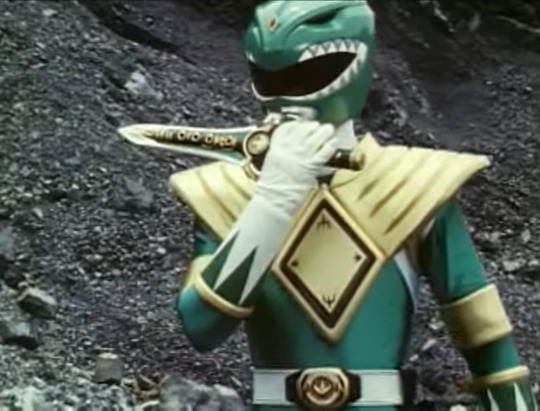
I think now's a good time to talk about the Green Ranger's design. It's nothing short of amazing. I absolutely love the way the gold armor looks on him, as well as the gold armbands and the little speck of red on the helmet. There's also the Dragon Dagger, a dagger that doubles as a flute capable of playing a theme that's just as iconic as his design.
youtube
Of course, like the other Rangers, another suit was made for American scenes, and it's worth talking about for all the wrong reasons.

The armor for this suit is very flimsy, and you can tell when it's being used due to how cheap it looks. Supposedly, it was done so it would be easier for the actor to move around in, but don’t quote me on this.
Anyway, while Tommy still joined the team, there was a bit of a problem. His Sentai counterpart, Burai, wasn't able to go outside and fight with his teammates for too long for reasons that are way too complicated to explain, so long story short, the writers for Mighty Morphin' decided to work around that by always having Tommy be busy with something, usually karate practice. It honestly made it hard to really see him as part of the team initially with how distracted he seemed to get.
Of course, there were some exceptions to this, with a couple episodes focusing more on Tommy, like “The Spit Flower”, which focused on his friendship with Kimberly. A float Kimberly was working on to be in a parade to meant promote world peace is targeted by Rita (being the petty bitch she is), and after her Putties lay waste to the float design, it devastates her. Kudos to Amy Jo Johnson's performance in this scene. Generally, Tommy and Kimberly have some great interactions here, and their actors work well together. While the Rangers deal with Rita's new monster, Spit Flower, Tommy secretly works to repair the model used for Kimberly's float in order to surprise her when the Rangers watch it on TV. Overall, a pretty wholesome episode, and one that would further the romance between Tommy and Kimberly.
“Gung Ho!”, is an episode that focused on Tommy's growing friendship with Jason. In this episode, the two are training for the Team Ninja Finals, but keep butting heads. Trini says they need to “gung ho”, claiming it's Chinese for “work together”... a term which is wrong for several reasons as while the original term was taken from “gōnghé”, the shortened term for the Gōngyè Hézuòshè organizations established in China. But putting aside the misuse of a Chinese term in an episode of an American TV show adapting footage from a Japanese TV show, Bulk and Skull then show up Tommy and Jason with the two ninja competitors who are shown to be far better at being ninja thanks to being dressed up like stereotypical ninja straight out of Miami Connection.

As for Rita, her latest plan involves sending upgraded versions of the Putty Patrollers after the Rangers. These Putties are nearly indestructible, so Zordon sends Jason and Tommy to find the Thunder Slingers, new weapons that should be able to destroy them, while the other Rangers try and hold them off. Once they get near the Thunder Slingers, they struggle to beat the guardian of the weapons, Titanus, a new Zord themed after a brachiosaurus. Deciding to take Trini's advice, Jason and Tommy come up with a new plan. While Jason runs up the hill while wearing Tommy's Dragon Armor, Tommy borrows Jason's Power Sword to distract Titanus. The two pass, get the weapons, and once the Rangers use them to defeat the Super Putties, the Thunder Slingers are never used again. But hey, at least now they can get the help of Titanus when they need it. The episode ends with Jason and Tommy taking on Bulk and Skull's ninja in the competition in a very well choreographed fight scene. Overall, a pretty fun episode about teamwork.
Unfortunately, the writers of this show were running out of Green Ranger footage, and rather than kill him off like what happened with his Sentai counterpart, they decided to go a different route in the two-part episode, “The Green Candle”. A nervous Tommy's plans to ask Kimberly to a dance are interrupted when Rita's forces kidnap him, and Goldar gives him an ultimatum: Serve Rita and keep his powers, or permanently lose them, thanks to the titular Green Candle. While Tommy was under Rita's control, he touched this magic candle that connected it to his powers. Once the Candle burns out, Tommy's powers will be transferred to Rita. Why it took her this long to break it out is anyone's guess.
Being the only one who has been to Rita's base of operations before, Jason volunteers to break into the palace and take the Green Candle in order to save Tommy's powers. In spite of this, Tommy doesn't want Jason to take the risk when it's his powers that are on the line. It's interesting to see Tommy in this position where he doesn't want Jason to get hurt for his sake, as it implies that he could still have some guilt for his actions while he was brainwashed by Rita.
While the other Rangers set up a way for Jason to enter Rita's palace, one of her monsters, Cyclops, forces Tommy into action, even though he's all alone. Eventually, Zordon forces the Rangers to abort the mission, with Zack going in and pointing out that even if they get the candle, Tommy could still die. While the Rangers manage to defeat Cyclops, by that point, it's too late. The candle burns out, and the only way to stop Rita from getting Tommy's powers is if they're transferred to another Ranger, Jason. In spite of him losing his powers and being surrounded by the transformed Rangers, they all reassure Tommy that he will always be a Ranger. After losing his powers, Kimberly meets up with Tommy while he is training in the park, and after the two talk a little (with Tommy trying to reassure Kimberly that things will be okay without him), we get the first kiss in the history of the franchise. With his confidence renewed, Tommy asks Kimberly to go to the dance.
“The Green Candle” was a great episode, with a very personal conflict that didn't just rely on a monster Tommy had to punch, but a tiny object capable of stopping him from beating Rita forever. The ending where Tommy had to give up his powers is bittersweet, but we see him trying his best to keep himself busy to deal with the big change in his life. The kiss with Kimberly also serves as a great start to their budding relationship since she and Tommy first met at the start of “Green With Evil”. If this was the final appearance of Tommy in the franchise, I don't think I honestly would have minded, as it was executed brilliantly.
However, it wasn't the end for Tommy. Because of how popular the show was, this caused Saban Entertainment to commission Toei to film new footage with the Rangers and new monsters, after they had exhausted all the remaining footage from Kyoryu Sentai Zyuranger. While Jason did get to use the Dragonzord and Dragon Dagger when needed for a few episodes, it wasn't long until the new footage paved the way for a return of an old friend.
The two-part episode, “Return of an Old Friend” features, what else, the return of Tommy. In this episode, Rita's latest monster, Dramole, helps Goldar steal the Dragon Dagger, and Goldar uses it to sic the Dragonzord on Angel Grove. In addition, Dramole helped to brainwash and kidnap the parents of the Rangers, and Goldar demands they give up their Power Coins in order to get their parents back. Goldar, being evil, lies about giving them back as soon he has the Power Coins, meaning the Rangers are now helpless to stop them.
However, Jason reveals they still have the Dragon Power Coin, as the first part ends with a dramatic reveal of Tommy that was kind of ruined by the opening crediting Jason David Frank as a guest star, in addition to me saying he returns in this episode. In the second part, Tommy is teleported to the Command Center and gets briefed on the situation. With the Green Ranger powers still being heavily drained, Zordon uses his own energy to jumpstart Tommy's powers, but not only does doing so nearly kill him, but there's a chance that the powers will run dry completely during a fight.
So yeah, this isn't exactly a triumphant return for Tommy as a Power Ranger, and his first fight in this episode will set the stage for the rest of his tenure as the Green Ranger. While he was able to take out the other five Rangers in the first part of “Green With Evil”, here, he struggles to keep up with Goldar and a group of Putty Patrollers. Tommy barely manages to get the Dragon Dagger and the other five Power Coins, and even then, it took a temporary power boost from Alpha. Afterwards, he's knocked unconscious just as he's teleported back to the Command Center.
While the other Rangers take on Dramole, it turns out that after being electrocuted by the force field set up by Goldar designed to protect the Power Coins, Tommy's powers were recharged once more. They're still temporary, but now, they're far more stable. After helping the Rangers defeat Dramole, Tommy is welcomed back into the team.
All and all, this was a pretty creative way to bring back Tommy. It still reintroduced the character and gave him back his powers, but the story made it clear that they weren't just going to ignore what the Green Candle did to him. Once the second season of Mighty Morphin' Power Rangers started, it became clear that it was only a matter of time until the Green Ranger powers were lost permanently.
The first major warning sign came in the three-part second season premiere, “The Mutiny”. When a new villain, Lord Zedd (Voiced by Robert Axelrod), usurps command from Rita and focuses his sights on Earth, Zordon gives the Rangers new Zords to fight his monsters with, but Tommy isn't able to access one for himself, as his powers are too weak to convert his old Zord into a Thunderzord like the others. The next sign came in “The Green Dream”, where Tommy wasn't even able to summon the Dragonzord to help the Rangers during a Megazord fight. The next few episodes have an underlying sense of dread to them, as it's established that the Green Ranger powers have almost run dry, not helped by the fact that Lord Zedd has been directly targeting Tommy to ensure he would lose his.
This all culminates in the two-part episode, “Green No More”. While Kimberly tries to comfort Tommy one day, an image of the latter appears, claiming to be from the future. All he can say is he's in the middle of “the final battle”, and that Tommy needs to remember to bring his communicator. The message rings true, as Zordon informs Tommy that he only has enough energy to morph into the Green Ranger one last time. Lord Zedd planned for this, sending the monster Turbanshell to draw Tommy out to morph one last time, only to transport him and steal the powers for himself. Part I ends with Lord Zedd using the siphoned Green Ranger powers to use for his own team of evil Power Rangers, and Tommy is cornered by Turbanshell, sweating heavily and very afraid.
In Part II, Goldar shows up to order Turbanshell somewhere else while he deals with Tommy himself. It makes sense, as not only has Goldar been a consistent threat to the Rangers, but the very first battle Tommy fought after getting the Green Ranger powers back involved Goldar. Rather than simply kill him now, Goldar takes the opportunity to mock the powerless Tommy by reminding him of how strong he used to be, all to further punctuate that Tommy's time as the Green Ranger is over. And right before he prepares to finish him off, Goldar tells Tommy that he wants to hear him say that Goldar is his superior. Tommy hesitates for a few seconds, before he defiantly tells Goldar that he is out of his mind. With a reinvigorated spirit, Tommy jumps into action against Goldar as his theme song, “Go Green Ranger”, plays, showing that whether he has the powers or not, Tommy will always be the Green Ranger.
During his last stand, Tommy manages to steal the device Goldar used to show Tommy footage of his old battles, and sends him away. Realizing it's a time device, he uses it to contact his past self and get his communicator, using it to teleport to Lord Zedd's hideout and smashes the Green Crystal powering Zedd's evil Rangers. While he gets enough energy for one more one more fight, after Turbanshell is defeated, Tommy's tenure as the Green Ranger officially ends.
Overall, this arc was a real highlight for Tommy as a character. The way his insecurities were explored was very compelling to watch, and seeing him save the day even after losing his powers was a triumphant sight, as was his realization that powers don't make the hero. While he would miss being a hero, just like at the end of “The Green Candle”, he's shown to be moving on. The very next episode, “Missing Green”, shows Tommy writing a letter to Jason letting him know that he doesn't blame him for not getting the Green Candle back in Season 1. This whole arc really showed Tommy growing as a person, showing that he wasn't the forgetful hothead we were first introduced to.
But because Tommy was easily the most marketable character in the show, and because Gosei Sentai Dairanger also had a Sixth Ranger, it was a no-brainer on Saban's part on how they could adapt this character.
(Part Two, A White to Behold)
After being absent for a whopping three episodes, Tommy returns in the two-part episode, “White Light”. After some secret keeping from Zordon and Alpha during the first part, they reveal the fruits of their efforts: A new White Ranger. And while it's well known by now that Tommy is the White Ranger, it was a pretty shocking twist for audiences thanks to the intrigue built up by the first part, in addition to the other characters introduced as potential allies to the Rangers. In fact, I'm pretty sure this was what was going through a lot of kids' heads back when “White Light” first aired.
youtube
The way that the White Ranger is introduced is nothing short of awe-inspiring. The way he's initially shown in a flash of white light and descends from above, giving him a bit of an otherworldly presence. It's a brilliant way to contrast the more sinister introduction the Green Ranger got in “Green With Evil”, where he was shrouded in smoke and was introduced with Rita's evil chanting.
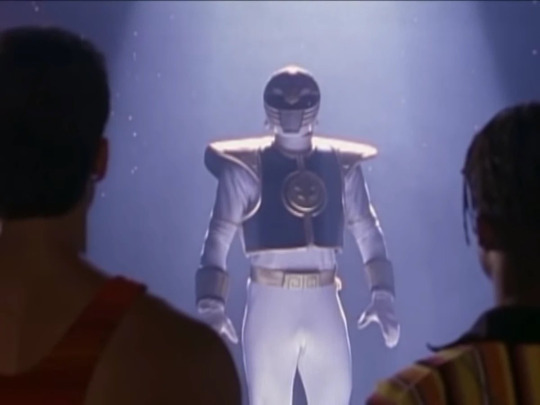
While I personally prefer the Green Ranger's design, I still think the White Ranger's suit looks really damn sleek. I love the way the armor looks, and the gold goes perfectly with the white and black. He gives off the impression of a truly heroic figure.
Not only is Tommy presented with a talking sword named Saba in order to control his own Thunderzord, the White Tigerzord, but Zordon also declares that he will be the new leader of the team. This was most likely done for two reasons: One, it was obvious that Tommy was the most popular character in the show, and two, there were some behind the scenes issues with Austin St. John, Walter Jones, and Thuy Trang even before they all left the show out of protest for their unfair treatment and minimal pay, so this could have been the writers subtly trying to give less focus to Jason, Zack, and Trini to prepare for their actors walking off.
Tommy uses his new White Tigerzord to destroy Lord Zedd's latest monster, Nimrod, and afterwards, is welcomed back into the team. Also, Rita was freed from her dumpster prison for like a minute or two, but that wasn't really as important as it sounded. Overall, a pretty solid way to welcome Tommy back into the team.
The very next episode, “Two for One”, develops Tommy's relationship with Kimberly as the two go on a date. It's some pretty cute stuff, and Jason David Frank has some great chemistry with Amy Jo Johnson. The two even dance for a brief moment before they fend off some Putties. This episode also shows off the physical prowess of the White Ranger powers, as Tommy is able to take care of a monster, Pursehead, on his own, albeit with a little help from Saba.
Surprisingly, despite becoming the main character at this point, Tommy didn't get a lot of focus episodes for a while. I think this was mainly because of the aforementioned departures of Jason, Zack, and Trini's respective actors, so the main priority of the writers was focusing more on the introduction of their replacements, Rocky, Adam, and Aisha (Played by Steve Cardenas, Johnny Yong Bosch, and Karan Ashley respectively). Tommy still took charge of the team during the action, but he more or less got less focus than he did at the beginning of the season.
That changed after a while, as he got a three-part episode dedicated to focusing on him, “Return of the Green Ranger”. Rita (Who at this point, had returned and married Lord Zedd) summons the Wizard of Deception to help Lord Zedd in his plan to send the Rangers back in time, but she points out that with Tommy to lead them, the plan will only work if he's out of the picture. The Wizard sends a squadron of Putties to ambush Tommy, knocking him out so he can steal a lock of his long-ass 90's hair to create an evil clone of him. Uh... you know you could have just killed him while he was unconscious, right? I mean, yeah, the Wizard's initial attempt to brainwash Bulk and Skull into cutting it off for him, but if the Putties had already restrained him, what was stopping you from deep frying him with your magic while he was unconscious? I just think it would have made more sense if the Putties managed to cut off some of the hair during the heat of the battle, instead of a plan that would make this Wizard look like an idiot.
The clone, called Tom Oliver by most fans, tricks the Rangers into falling for the Wizard's trap, who sends them back to colonial Angel Grove, specifically around the late 18th century, as it's being invaded by British troops... even though California wasn't officially recognized as a state until around the mid-19th century, and before then, it was a Spanish colony. Also, this might be due to the fact that I'm a New England native, but I'm pretty sure the original American colonies were on the eastern coast, not the western coast, which the British never invaded. Did I mention that this episode was the result of Saban needing to cobble together another few episodes as a result of filming for the 1995 movie in Australia taking longer than expected?
While the Rangers are trapped in a historian's worst nightmare, Tommy is confronted by Tom, and we see that Tom serves as a way to show the audience how Tommy could have turned out if he stayed under Rita's influence back in Season 1, a cruel and bitter man who flaunts his superiority over others, eager to pick a fight with someone. Both Tommy and Tom morph, and while I'm not a fan of how complicated the setup is, I can't deny how awesome the fight between the Green Ranger and the White Ranger is. The action is fast-paced, and both of them get a lot of good blows in to the point where sparks fly from their punches.
After knocking out Tommy, the Wizard of Deception once again forgets to actually kill him and leaves him unconscious while ordering Tom to hijack the Dragonzord to attack Angel Grove with. Tommy eventually comes to, and he's noticeably exhausted from the fight, which Zordon explains is a result of the clone draining Tommy of his energy when the Wizard created Tom. It gets to the point where he can barely stagger up a flight of stairs, and while morphing should revitalize him, it'll only be temporary. Tommy morphs and summons the White Tigerzord to fight the Dragonzord with, and this is another impressive fight. Yeah, it's pretty short, but I'm surprised at how well the editors managed to blend the Zyuranger and Dairanger footage together. I question how the Tigerzord in Warrior Mode was able to lose to the Dragonzord when it's supposed to be stronger, but then again, the writers just established that Tommy isn't at 100% at the moment, so that could be a possible explanation.
Tommy is cornered by Tom and the Wizard, and when given the chance to surrender, Tommy tricks them into telling him what time period the other Rangers are in, stealing the Wizard's wand and traveling to rescue them before traveling back and killing the Wizard himself. Tom feels remorseful for being controlled by the Wizard. I guess it's meant to parallel how Tommy felt at the end of “Green With Evil”, but it doesn't work because unlike Tommy, Tom was born evil from the start. The two go back in time to deal with some mutant rat monsters they left in colonial Angel Grove (Which might sound like a big deal, but it really isn't), and afterwards, Tom decides to stay with the colonists. I'd question how this will affect history, but this isn't even the first or last time Mighty Morphin' will screw up the timeline, to say nothing about what would happen in future seasons like Time Force or Dino Charge.
Overall, while the actual fight between the Green and White Rangers was fun, this three-parter just wasn't that good. It dragged on, and once you learn that it was created to fill in a gap of episodes while the cast and crew were in Australia, it explains why there are so many plotholes. I'd still recommend at least checking out the scenes between Tommy and Tom to see how much the former has changed, but it's just a very forgettable episode that really didn't need to be three parts long.
Not long after this episode, Season 2 ended, and Season 3 kicked off with the destruction of the Thunderzords, forcing the Rangers to go on a quest to meet the creator of the Power Coins, Ninjor (Voiced by Kim Strauss). He gives them a new set of Zords, the Ninjazords. Tommy's Ninjazord was the Falconzord, which would actually play a bigger role in the season's story than the Dragonzord or Tigerzord.
It was mostly business as usual after the Rangers got their new Zords, until the two-part episode, “A Ranger Catastrophe”. Aisha takes in a stray cat, which is secretly one of Rita's newest minions. Why would Rita have a cat spy on the Rangers? Well, the cat is actually a girl in disguise, creatively named Kat (Played by Catherine Sutherland). She pretends to flirt with Tommy, only to lure him into a trap set by Rita, who is currently brainwashing her. After Tommy escapes, Rita turns Kat into a cat-themed monster called Catastrophe, who the Rangers easily defeat. While it seems like Kat is free, it's all a ruse that leads into the next episode, “Changing of the Zords”.
In that three-part episode, we see Kat is jealous of Tommy and Kimberly's relationship, though it's unclear how much of it is thanks to Rita's spell. Her next order is to steal one of the Rangers' Power Coins, as it's part of Rita and Zedd's plan to activate a new set of dormant Zords, the Shogunzords, which they need a Power Coin and the Ninjazord technology to use in order to reawaken them. While the Rangers are busy fighting Zedd and Rita's new footsoldiers, the Tengas, Kat steals Kimberly's Power Coin, which immediately weakens Kimberly, just like what happened with Tommy back in Season 2. Not long after stealing the Power Coin, Kat hijacks the Falconzord as well, while Ninjor is captured by Lord Zedd to be used as a power source for the new Zords. Also, did I mention that for some reason, without the Falconzord, the Rangers can't access the other Ninjazords?
We get a pretty interesting character moment showing how Tommy comprehends the defeat of the Rangers, showing his determination to keep fighting. In general, Tommy is very protective of Kim with everything that's happened, especially since Zordon revealed that because the new Power Coins are connected to the Rangers' life forces, Kimberly is in even more danger than Tommy was in Season 2. It gives Tommy a more personal stake in this conflict, and adds more drama to the story.
Eventually, the Rangers take back the Shogunzords from Zedd, giving them a small victory even though he still has Kimberly's Power Coin and Ninjor, while Kimberly (now in less danger since Alpha severed her physical connection to her Power Coin) has to draw from the other Rangers' powers in order to morph until they get her Coin back. Overall, a very important episode that furthers Season 3's story, and shows how much Tommy cares for Kimberly.
Long story short, over the course of the three-part episode “A Different Shade of Pink”, after the spell on her is broken, Kat takes back Kimberly's Power Coin, and when an opportunity to train for a major international gymnastics competition in Florida comes up, Kimberly transfers her Pink Ranger powers to Kat. Tommy admits that while he doesn't want to say goodbye to Kimberly, he still is willing to say goodbye in the hopes that they can make things work long-distance. While this arc does focus primarily on Kimberly and Kat, it's still worth watching as it's the last time we'll really focus on Tommy's relationship with Kimberly. Well, second to last, but trust me, we'll get there.
“Master Vile and the Metallic Armor” is another three-part episode that is focused more on the team's conflict with a new villain, Master Vile (Voiced by Simon Prescott) while trying to save Ninjor. It also has a really important moment for Tommy's character. Master Vile's plan is to obtain the powerful Zeo Crystal, which is protected by a force field that can only be bypassed by someone pure of heart. Tommy attempts to get the Crystal, and while it initially puts him in unimaginable pain as he's forced to relive the evil deeds he committed as the Green Ranger, the force field soon eases as it recognizes all the good he's done as the Green Ranger and the White Ranger, letting him get the Crystal. It's short, but it's a powerful scene that illustrates how far Tommy has come as a character.
Tommy's tenure as the White Ranger ends abruptly in “Rangers in Reverse”, as Master Vile casts a spell to reverse time and turn the Rangers into kids, meaning they can't use their powers. After Rita and Zedd destroy the Power Coins as well, the Rangers are forced to search for the fragments of the Zeo Crystal they scattered through time in order to get new powers. During his Zeo quest, Tommy also gets a half of a Native American arrowhead which will be important later on. Although the Zeo Crytsal is reassembled and time is restored, the villains ultimately get the last laugh as they set off a bomb that destroys the Command Center, truly signaling the end of the Mighty Morphin Power Rangers... for about two months, then Power Rangers Zeo premiered, giving Tommy a new set of powers.
Also, Aisha was replaced by a new girl, Tanya (Played by Nakia Burrise) because of time travel stuff he wasn't part of, but it's not that important right now.
(Part Three, Red-Ey or Not, Here He Comes)
Power Rangers Zeo opens with the two-part episode, “A Zeo Beginning”. Even with the destruction of the Command Center, it turns out that Zordon and Alpha had a backup base of operations, the Power Chamber. Using the Zeo Crystal, they then create new Morphers, the Zeonizers, for the Rangers to use, albeit without Billy since the Crystal only has enough power for five Rangers, so Tanya steps up as Aisha's replacement. Like Rocky and Adam, Tommy is given a new color with the Zeo powers. In this case, he's Zeo Ranger V, Red.
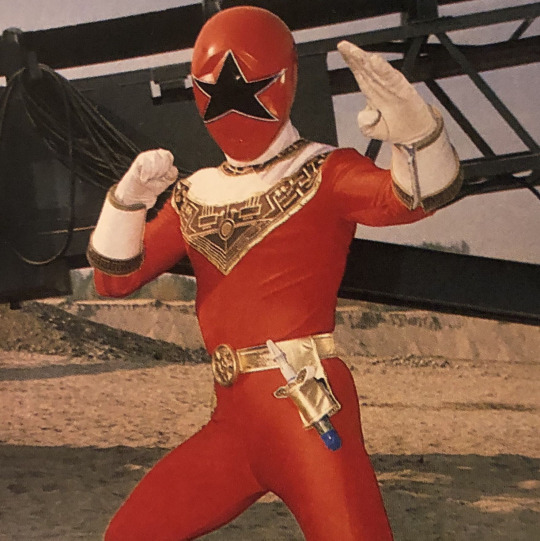
I really like the designs of the Zeo suits, and Zeo Ranger V is no exception. I love the use of white and gold near the top, and the star helmet makes the suit stand out compared to the previous two animal forms.
Surprisingly, while he became the leader, Tommy didn't get as much focus as he did in Mighty Morphin', mostly due to the show trying to settle into the new status quo in addition to establishing Tanya as a character and the new villains, the Machine Empire. That changed in a seven-part arc focusing on Tommy's mental conflict. “There's No Business Like Snow Business” was a three-part episode that opened with one of the biggest flaws of Zeo as a whole: Kimberly writing a “Dear John” letter to Tommy, announcing she met someone else while in Florida, and that she's breaking off their relationship. Why would they have Kimberly dump Tommy offscreen without the dignity of an actual breakup? To set up a new romantic subplot with Kat, of course!
Yeah, this is where a lot of fans believed the Tommy focus got to be too much, as not only was the Tommy/Kat ship hard for viewers to get used to after how well-written Tommy's relationship with Kimberly was, but it was very easy for the writers to pair Kat up with someone else instead, like Billy, Rocky, Adam, or another side character entirely. It also didn't help that there were a lot of plans to confirm the two tied the knot, mainly both of Kat's planned cameos as Tommy's wife in Wild Force and Dino Thunder (although neither came to fruition), a hint at that happening in Ninja Steel when the two hold hands near the end of “Dimensions in Danger”, and this was all after the infamous Christmas special, “A Season to Remember”, which showed that Tommy and Kat got married and became grandparents in the future.
“Inner Spirit”, “Challenges”, “Found and Lost”, and “Brother, Can You Spare an Arrowhead?” is a four part story arc that follows up on the arrowhead half Tommy got at during his Zeo quest. After Tommy has a strange dream about the Rangers being defeated, which soon comes to pass as the Rangers fight the Machine Empire's newest soldier, Main Drain. Zordon and Billy reveal that they've been working on a new Zord for Tommy, the Red Battlezord. However, because of the technology syncing up with his brainwaves, all the stress of the past few episodes has gotten to Tommy, causing him to crash the Zord into the ground. With advice from the man who helped him on his Zeo quest, Sam Trueheart (Played by Frank Salsedo), Tommy soon musters up the calm state of mind needed to properly use the Red Battlezord. Over the course of the next few episodes, Tommy reunites with the person who had the second half of the arrowhead, his long lost brother, David (Played by Jason David Frank's late brother, Erik Frank). Although it's interesting to see Tommy learn more about his Native American heritage, this arc hasn't exactly aged well thanks to relying on a lot of stereotypical depictions of the culture that were prevalent in the 90's, specifically the whole “vision quest” and wise old man with magic powers connected to the land.
Later on, a new mysterious Ranger is introduced, the Gold Ranger. While there's some initial speculation on his identity, “Revelations of Gold” reveals him to be an alien with three distinct personalities known as Trey of Triforia (Played by triplets, Tom, Tim, and Ted DiFillippo). In order for the three personalities to reunite as one again, Trey needs to transfer his powers, and Tommy has an idea for a candidate: the former Red Mighty Morphin' Power Ranger, Jason. The powers don't last for long, as Jason's body soon starts to reject them, putting him in a similar position to Tommy when he was losing the Green Ranger powers, so eventually, he has to transfer them back to Trey in the finale of Zeo, “Good as Gold”. We also get a really nice scene where Tommy tries to comfort Jason after the final battle, citing his own experiences losing his powers. It's really interesting to see their positions flipped here, especially since Jason took failing Tommy hard back in “Missing Green”.
Generally, Zeo furthered Tommy's character into more of a leader who was more sure of himself and wasn't nearly as headstrong as he was back when he was the Green Ranger or White Ranger. While Tommy was already leader when he became the White Ranger, this was when his role as team leader was truly cemented in my opinion, and was one of the high points of his character. The next season would try to focus on this... with mixed results.
Tommy's next set of powers would come in Turbo: A Power Rangers Movie, the pilot to Power Rangers Turbo. After the Rangers defeat the Machine Empire, space pirate Divatox (Played by Hilary Shepard Turner) kidnaps an alien wizard named Larigot, along with Jason and Kimberly, in order to use them as sacrifices to awaken the demon Maligor. The Rangers give chase, albeit with new powers and Zords to replicate the magical key needed to enter the mystical island, turning the Zeo Rangers into the Turbo Rangers. Tommy, of course, stays the Red Ranger.

The Red Turbo Ranger suit is... okay. It doesn't really stand out other than the chrome lining on the helmet. I never really got the trapezoid emblem on the chest either.
While most of this movie is pretty boring, the climax is interesting because of how Jason and Kimberly are involved. Originally, they were the ones who had the closest ties with Tommy, and they were the ones who wanted to save him the most while he was under Rita's control. Now, Tommy has to step up and show how much he's grown as a hero in order to save the people who once saved him. After he does, he and Jason easily win a karate tournament to raise money for a local shelter, showing how far their teamwork has come.
In the actual Power Rangers Turbo show, Tommy was tested as a leader as soon as the fourth episode, “Shadow Rangers”. When the other four Rangers were cloned, Tommy tries to get guidance from the team's new mentor, Dimitria (Played by Carol Hoyt), but all she does is ask questions, showing she's less of a hands-on mentor than Zordon was. This forces Tommy to figure things out himself, part of the theme of this show's first half, growing up and learning to do things on your own.
Compared to his last three Ranger forms, Tommy's tenure as the Red Turbo Ranger would be short-lived, as he would transfer his powers to T.J. Johnson (Played by Selwyn Ward) in “Passing the Torch”. This was because Jason David Frank wanted out of the franchise after almost four years, and let's be honest, despite having nineteen episodes to build up to it, the actual transfer really could have been handled better. There's no real in-universe explanation as to why Tommy had to retire other than him supposedly being too old for the role, judging from Dimitria's statement at the end of “Passing the Torch”, and Tommy barely got to know T.J. before the latter became the new Red Turbo Ranger. It makes the whole transfer seem less impactful when compared to Kimberly transferring her powers to Kat in Mighty Morphin', and the fact that Adam, Tanya, and Kat were also written off for the same reason with just as little fanfare didn't help things at all.
Nevertheless, it seemed like Tommy's time as a Ranger was over, and it was for a few years, not counting a guest appearance in Wild Force. However, he would return for one more season as a regular down the line and prove that while he may be old, but he can still pull it off.
(Part Four, Black Into Action)
Tommy's major return to the franchise came in Power Rangers Dino Thunder's very first episode, the two-part “Day of the Dino”. Between the events of this season and Turbo, Tommy got a degree in paleontology and became a high school science teacher at Reefside High School. How he managed to get through all that in seven years is anyone's guess. Maybe Zordon put in a letter of recommendation for whatever university Tommy chose?
Here, Tommy is much more calm and composed, but he isn't afraid to snark if the situation calls for it, and he hasn't lost his martial arts prowess in the slightest. At the same time, this show established a more intellectual side to him, which helps play into his backstory. While working with Dr. Anton Mercer (Played by Latham Gaines), Tommy attempted to try and fuse dinosaur DNA with technology, but the project soon got out of hand after Mercer tested it on himself, giving him an evil split personality, Mesogog. It's clear that Tommy has a lot of regret regarding what happened to the project he worked on, and is trying his best to stop it.
After his first day as a teacher, Tommy would be forced to supervise three of his students, Connor, Ethan, and Kira (Played by James Napier, Kevin Duhaney, and Emma Lahana respectively), during detention. He takes the three to a museum, but while he sends them off to do some investigating for a mission, he encounters a robotic T-Rex, and does what only Tommy Oliver could do: KICK IT IN THE FACE!
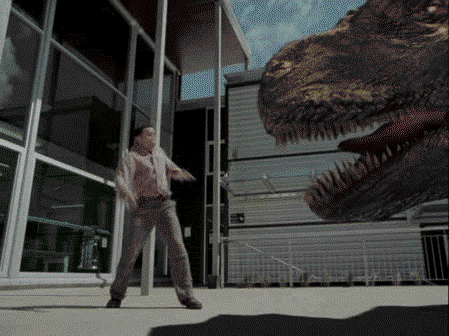
Goddamn it, I love this character.
While he fends off the robot, Connor, Ethan, and Kira accidentally stumble upon Tommy's underground lab where they find a trio of colorful gems which give them superpowers. These gems, appropriately called the Dino Gems, bond with the three, which is bad because that's what Mesogog wants to use in order to bring Earth back to the prehistoric era. The new recruits get the hang of being Rangers pretty quickly, but their first major challenge came earlier than expected when Tommy is kidnapped by Mesogog's forces at the end of the next episode, “Wave Goodbye”, with Mesogog intending to force Tommy to help him unlock the secrets of a mysterious stone.
In the next episode after that, “Legacy of Power” while trying to figure out where he is by having Ethan hack into his computer, the Rangers learn that Tommy used to be a Power Ranger after he alluded to it a few times earlier. While the episode is mostly a clip show to commemorate the franchise's 500th episode (the clips in question coming from a video log Tommy set up going over the history of the Power Rangers), we get a really strong scene at the end where he says he believes that Connor, Ethan, and Kira can protect the planet as a team, showing how much trust he has in the new generation.
The Rangers go and rescue Tommy in the very next episode, “Back in Black”, and when it seems like he's killed by one of Mesogog's generals, Zeltrax (Voiced by James Gaylyn), Tommy reveals that the stone Mesogog was so determined to use was actually a new, black Dino Gem. Tommy bonds with the Gem, and once again, becomes a Power Ranger.
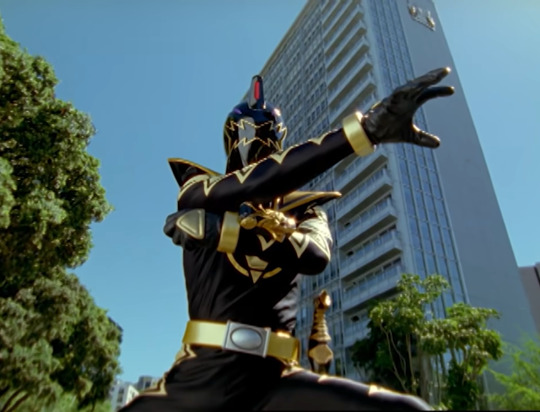
And so Tommy morphs into his final Ranger form, the Black Dino Ranger. This is honestly my second favorite of Tommy's Ranger suits, the first being the Green Ranger suit. I love the way it has more of an armored look with the shoulderpads and the golden scales make him stand out compared to the other Dino Rangers. It probably wasn't the intention, but it almost looks like an evolution of the Green Ranger suit with how the gold is used.
So Tommy goes back to kicking ass and taking names as a Ranger, but he's more in a supportive role and not the leader outright. He does his best to mentor the Rangers and even connects a little with another one of his students, Trent (Played by Jeffrey Parazzo), showing how much he cares about the kids he's in charge of.
Of course, things would go south for Trent and the Rangers in the three-part episode “White Thunder”, as he accidentally discovers Mesogog's lair, and becomes the White Dino Ranger after finding a white Dino Gem. Like Tommy all the way back in “Green With Evil”, Trent isn't fully in control of his actions thanks to the Gem's influence, but would still go on to ABSOLUTELY WRECK THE SHIT OUT OF THE OTHER RANGERS. Not only does he beat the crap out of them, he steals two of the Rangers' Zords, the Dragozord and the Stegozord, and to top it all off, traps Tommy in an amber cocoon before he can tell the others who the White Dino Ranger really is. To make things worse, two episodes later, he's freed from the amber, but now he can't demorph.
This was something Jason David Frank had actually requested behind the scenes. He wanted to spend more time with his family and run his martial arts school back in America, as opposed to being in New Zealand to film the entire season. Therefore, the decision was made to keep Tommy morphed permanently so all Jason David Frank had to do was record some lines to dub over his suit actor's performance in post-production. So for the next ten episodes, Tommy stayed morphed, and not much really changed aside from that. He still stayed in a supportive role, but had to step back from the school scenes, and wasn't as involved with the action in some episodes. The only problem I really had with this was that they never really showed any downside to this. I guess if I had to write this subplot, I'd make it so Tommy has to conserve his energy in order to sustain himself instead of eating or drinking, sort of like what he had to do back when the Green Ranger powers were starting to run out. I think it would justify his absence from certain episodes better.
That being said, they still give Tommy focus here, and it leads to other cool moments. In the very first episode after he's freed from the amber, “Burning at Both Ends”, Tommy sees through a ploy from Trent giving him a new ATV as a way to show he turned a new leaf by asking Trent a false question about said ATV, because “they don't make twelve-stroke engines”. Another interesting moment comes in “Bully for Ethan”, where Kira helps him go through some old pictures, and we get to see a picture of the original six Power Rangers.

It's small, but it's a nice bit of fanservice, as is the picture of Tommy's ancestor seen in “Wild West Rangers”, the White Stranger.
They also focus more on why Zeltrax hates Tommy so much. It turns out that Zeltrax is actually an old friend of Tommy's, Terrance “Smitty” Smith, and Smitty hates Tommy thanks to Anton Mercer choosing him for a job instead of him, not knowing that his new boss, Mesogog, is actually Mercer. Not much really comes of this rivalry (it doesn't help that we barely know who Smitty is outside of flashbacks), but it's interesting to see Tommy try to reason with his old friend like what Jason did with him all those years ago, only to be forced to seemingly take him down by himself in “A Star is Torn”.
In “Disappearing Act”, the Rangers find a mysterious slime that manages to get Tommy to finally demorph... but now his Dino Gem's invisibility power is active 24/7. This leads us to the next episode, and one I can imagine Power Rangers fans have been waiting for me to talk about for a while now, “Fighting Spirit”. Using the black Dino Gem, they turn him back... but this sends him into a coma. While the Rangers head out to fight a new monster, Tommy starts to dream about fighting his old Ranger forms, Zeo Ranger V, the White Mighty Morphin' Power Ranger, and the Green Mighty Morphin' Power Ranger.
The scenes in Tommy's mind have been interpreted in different ways, and here's my take on the conflict. Zeo Ranger V represents the leader Tommy has become over the years, being calm and courteous when he greets the veteran Ranger, and refusing to use any weapons in their fight. The White Mighty Morphin' Power Ranger represents Tommy's headstrong nature, being the most aggressive of the three, and at one point, shouts at Tommy to get up and keep fighting. And the Green Mighty Morphin' Power Ranger represents Tommy's sense of personal discipline, almost like a mixture of the first two, as while he is the most direct about wanting to fight Tommy, he is courteous enough to lend him the Dragon Dagger before the two fight. Compared to V's question about being able to keep up the good fight or White aggressively demanding he keep fighting, Green also gives Tommy the chance to give up, testing his spirit instead of his body. Even in the face of adversity, Tommy refuses to give up, revealing the three Rangers were testing him. Tommy gets his Dino Gem back, and beats Mesogog's newest monster on his own.
Afterwards, the Rangers keep up the good fight until Tommy, like the other Rangers, is stripped of his powers in “Thunder Struck” when they all use the combined power of their Dino Gems to defeat Mesogog (who had already been separated from Mercer) once and for all.
(Part Five, Always a Ranger)
Now that we've gone over most of Tommy's tenure as a Ranger, it's time to talk about the way he is seen as an icon, in and out of universe.
Tommy's first return since his retirement in Turbo was in Wild Force's iconic 10th anniversary special, “Forever Red”. In this episode, the Red Rangers from the past ten seasons of the franchise team up to stop the remnants of the Machine Empire from unleashing Lord Zedd's old Zord, Serpentera. While the Red Wild Force Ranger, Cole (Played by Rick Medina), is introduced to all the older Red Rangers, T.J. specifically introduces Tommy as “a legend”, and earlier, when Tommy is called over by another Red Ranger, Bulk and Skull (who were running a little club he was relaxing at), they seem very hesitant to disturb him.
Tommy's next major return after Dino Thunder was during the finale to Megaforce, “Legendary Battle”, the 20th anniversary special. Here, he led the army of Legendary Rangers to help the Megaforce Rangers deal with the rest of the Armada's forces, essentially serving as the representative of the veterans giving their approval to the new generation... as unearned as it was, given how poorly the anniversary aspect of Megaforce was handled, but I digress. Although to be fair, while I'm just as critical of Megaforce as everyone else is, Tommy telling the Megaforce Rangers that “They'll always be with them” was pretty heartwarming, and is a testament to how long the franchise has been going for.
And the final televised appearance of Tommy Oliver before Jason David Frank's death would be Ninja Steel's “Dimensions in Danger”, the 25th anniversary special. When several veteran Rangers go missing, the Ninja Steel Rangers are contacted by three other veterans, and they explain for this mission, they specifically mention needing Tommy's help, the current team of Rangers seem to hold him in high regard. Later on, when Tommy is the one to save all of the captured Rangers, and later uses the Falconzord to save the day.
Obviously, these three anniversary specials seem to hold Tommy in high regard, but why is that? How did Tommy get so popular that he essentially became the face of the franchise?
For one thing, I'd say it's the first impression he made. Like I mentioned earlier on, “Green With Evil” was a big deal, and even though Tommy was brainwashed, he still got to show off a lot, and most of it was before he even got the iconic Dragonzord. Power Rangers has always been about teamwork, that everyone has their own strengths and weaknesses, but with Tommy, and pretty much every other Sixth Ranger after him, he stood out thanks to his more unique arsenal that put him on par with some of Rita's strongest monsters. He did just enough to shake up the cast during his first run as the Green Ranger, and let's be honest, he was pretty cool. Tommy was sort of like Batman or Wolverine, a hero who is recognized for being a total badass that kids love to see. I think that's why so many children wanted to see more of Tommy after “The Green Candle”.
At the same time, Tommy clearly had some depth to him. We saw him struggle to work together with Jason, he showed a level of dedication to making Kimberly happy while showing an artistic side to him, and when his Green Ranger powers were being drained in the first two seasons, he was put in a very vulnerable situation. This kind of drama made things more interesting to watch, and it made kids want to watch the show more to see what would happen to Tommy when Lord Zedd was personally targeting him in an effort to drain his powers entirely. Yeah, we know what happens now, but back in the 90's, kids didn't know if Tommy would get to stay a Power Ranger or not, which was what also made his debut as the White Ranger so shocking.
I think this was why Tommy was eventually promoted to Red Ranger in Zeo and Turbo, to solidify his role as leader of the team, although I do think the focus got a little out of hand in Zeo. Like I said, the romance subplot with Kat was very unnecessary in my opinion, and the four-parter with Tommy's Native American heritage coming right after a three-parter that set up his feelings for her really didn't help the perception that all he did was steal screentime from the other Rangers. I still feel like it got better in the first half of Turbo, as there was more focus given to the other Rangers before they all left, but I think more could have been done to place a greater emphasis on Tommy transferring his powers to T.J. instead of how rushed his exit was planned.
To me, I think Tommy was handled almost perfectly in Dino Thunder. Yes, there was a little bit of worshiping with him being built up as a legend in “Legacy of Power”, and yes, the whole thing with Zeltrax/Smitty was pretty pointless, but here, more emphasis was placed on his role as a close advisor to the team while there was plenty of focus given to the other four Dino Rangers. He was given the right amount of focus as a main character, but it wasn't enough that the other Rangers felt neglected by the writers.
Tommy Oliver is a character whose reputation precedes him for good reasons. He's been a huge part of the franchise ever since his introduction, has a surprising amount of depth to him, and he has essentially become the face of the franchise for years. I think that's one of the reasons why people were so shaken by Jason David Frank's death compared to other Ranger actors like Thuy Trang and Pua Magasiva. Generally, when we got the news that Jason David Frank died, it was like a huge part of the franchise died with him. It's hard to imagine what the franchise would have been like if Tommy wasn't so popular, but we can at least rest knowing that Jason David Frank and Tommy Oliver both played a huge part in getting the legacy of the Power Rangers started.
May the power protect you always, Mr. Frank.
#crimson ace reviews#power rangers#mighty morphin power rangers#power rangers zeo#power rangers turbo#power rangers dino thunder#tommy oliver
17 notes
·
View notes
Text
Crimson Ace Reviews: Power Rangers Samurai, a Nostalgic Translation
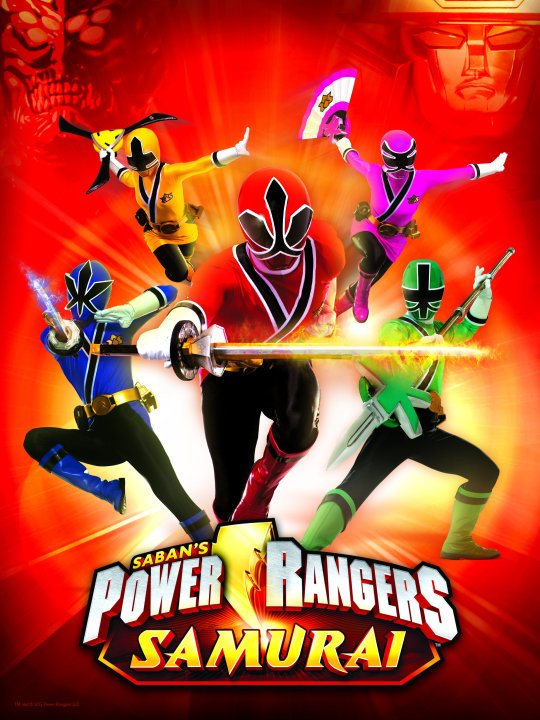
Let's be honest, if you're a fan of tokusatsu, Power Rangers is most likely one of the franchises that got you hooked in the first place. It's hard to deny the cultural impact the franchise has had in its nearly thirty-year run, in spite of its various ups and downs. Today, we're going to take a dive into one of the entries in the franchise that sparked a new generation of fans of Power Rangers, myself included. But first, let's go into the history of the circumstances behind this installment.
In 2001, Disney bought the rights to the Fox Family Channel, which Power Rangers was airing on at the time, leading to a lot of major changes behind the scenes. Despite the recent acquisition, the higher-ups wanted almost nothing to do with the franchise, and were about to cancel it until they were convinced that they could lower production costs if future installments were filmed in New Zealand as opposed to filming in California like it had been since the original Mighty Morphin' Power Rangers. In addition, Disney decided to make the show non-union, meaning a lot of the old crew was let go.
These changes, in addition to action scenes relying more on pyrotechnics, questionable performances from actors trying their hardest to hide their New Zealand accents, and a lack of strong continuity compared to when Saban Entertainment was running the show, ended up alienating a lot of long-time fans of the franchise, and causing a major divide in the fandom. And don't even get me started on how much of a nightmare production was. However, common consensus has changed over the years, and the Disney Era is looked back with more fondness than when it was first airing, though there's still debate on whether its better than the Saban era overall.
Eventually, after Power Rangers RPM finished airing in December 2009, Disney decided to officially pull the plug for a number of reasons like low toy sales, production costs increasing, and a general lack of interest in working with this franchise. However, in May 2010, Haim Saban, the man behind Power Rangers in the first place, bought back the rights to the franchise. He even managed to hire back one of the older executive producers for the franchise, Jonathan Tzachor, to aid in production.
This all sounds awesome, right? After almost a decade, Power Rangers is back in the hands of its creator, one of the older producers is coming back to work on it, and it can get a fresh start on another network. How can this lead to anything going wrong? Well...
Because Saban wanted the next season to premiere in February like most seasons did, the production team only had about six months to film the whole thing, coupled with Nickelodeon having weird rules for the franchise that would affect the airing schedule until the end of Dino Fury's first half, but I'll get to that later.
For now, let's take a look at Power Rangers Samurai
THE STORY
Centuries ago in Japan, Nighlok monsters invaded our world, but samurai warriors defeated them with power symbols passed down from parent to child. Today, the evil Nighlok have risen once again and plan to flood the Earth with water from the Sanzu River (which hydrates them but is deadly to everything else in the human realm) by causing human misery. Luckily, a new generation of heroes stand in their way. They are the Power Rangers Samurai.
This team consists of Jayden (Played by Alex Heartman), the charismatic, yet quiet Red Ranger with control over fire, Kevin (Played by Najee De-Tiege), the team's stoic Blue Ranger with the most traditionalist mindset and control over water, Mia (Played by Erika Fong), the Pink Ranger who is the most compassionate of the five and has control over wind, Mike (Played by Hector David Jr.), the Green Ranger who is arrogant, but still has a good heart and control over the forest, and Emily (Played by Brittany Anne-Pirtle), the Yellow Ranger who was actually forced to fill in for her sick older sister, and has control over earth. Later on, they're joined by Antonio (Played by Steven Skyler), a childhood friend of Jayden's who forged his own gear and becomes the Gold Ranger, with control over light.
The Rangers main ally comes in the form of Mentor Ji (Played by Rene Naufahu), a stern, but caring man who acts as Jayden's primary confidant and father figure. In addition, while they don't directly interact with the team for most of the season, we occasionally follow the comedic antics of returning Mighty Morphin' character Farkus “Bulk” Bulkmeyer (Played by Paul Schrier), and his young nephew, Spike (Played by Felix Ryan), as the two train to become samurai themselves.
As for the Nighlok, they consist of Master Xandred (Voiced by Jeff Szusterman), an angry warlord who spends most of his time waiting to be free while he drinks alcho—I MEAN MEDICINE, Octoroo (Also voiced by Jeff Szusterman), a more intelligent general who orchestrates a few of the group's schemes, Dayu (Voiced by Kate Elliot), the snarky female general whose music is able to help Master Xandred calm down, Deker (Played by Rick Medina), a human/Nighlok hybrid seeking to break his curse by finding a worthy opponent in battle, and Serrator (Voiced by Derek Judge), a deceptive intellectual with an agenda of his own.
Due to the rushed production, a lack of original Ranger footage, and Jonathan Tzachor generally being a huge fan of the Super Sentai season he was adapting, Samurai Sentai Shinkenger, the writing for the episodes fluctuated in quality. There would be some times where the dialogue didn't match the Sentai footage or story it was adapting, like in the very first episode, where Jayden tells the other Rangers that it's important they work together... right before charging off into battle on his own. The show generally tries to make Jayden out to be a more open leader without really acknowledging the struggles his Sentai counterpart had to go through while accepting the help of his teammates.
Then there are the episodes that try to adapt Shinkenger plots without understanding that there are moments where they tend to fit the Sentai characters more instead of making more of an effort to tweak the writing. “Forest for the Trees” is an episode that is supposed to portray Mike as lazy and not worthy of getting to pilot one of the new Zords on his own, but it doesn't work because in Shinkenger, Mike's counterpart was shown to slack off and didn't take things as serious as his teammates did, which justified the plot of the Shinkenger episode.
There are also times where even without the use of Sentai footage, episodes that adapt stories from Shinkenger tend to be iffy, either with the conflict or dialogue. A particularly glaring example comes from the episode “Jayden's Challenge”. Basically, Jayden runs away to fight the Nighlok on his own because he doesn't want the other Rangers to get hurt for his sake (long story short, only the Red Ranger can use the sacred sealing symbol to defeat Master Xandred for good, so the Nighlok start to target him more when they find out), but once the other Rangers catch up with him during the next Nighlok attack, Jayden says “I don't like putting you in danger, but someone has to stop the Nighlok... and I'm glad it's us.” The teamwork message isn't bad on paper, it's just that it doesn't really resolve the guilt Jayden feels regarding the other Rangers being willing to sacrifice themselves for his sake. I feel like the episode could have worked more if the conclusion he came to was that if he didn't want to endanger the other Rangers, he needed to focus on being a better leader instead of running away from his problems.
That's not to say all of the episodes are bad, as there are a handful of gems like “The Team Unites”, “There Go the Brides”, “Team Spirit”, and a few others in the second half. But before we get there, let's talk about the reason why I need to clarify the second half of this show is different: Nickelodeon.
For some odd reason, not only did the higher-ups at Nickelodeon mandate that that Samurai be split into two different twenty episode seasons, they also mandated the two part pilot episode, “Origins”, aired last in the first half when it's crucial for establishing the conflict of this season and introducing the characters. Seriously, even though the first episode that aired was called “The Team Unites”, the team is already united, and if you watched this as it premiered like I did, you were just thrown in and forced to understand what the hell was going on from the brief narration that plays at the beginning of every episode.
Then there was also how the writers tried to loosely connect the two seasons by extending an arc in Shinkenger and making it continue into the next season. When the battle with the Nighlok intensifies in “The Tengen Gate”, Mentor Ji suggests obtaining a mystical, yet unfinished talisman called the Black Box for Antonio to unlock the powers of. With how the conflict is framed, you would assume that the next episode, “Boxed In”, would focus on that power being on display, wouldn't you? Unfortunately, this concept gets dragged out/abandoned for the next few episodes since Antonio fails to complete the Black Box so it can be saved for the first episode of the second half of Samurai, Super Samurai... Except the one hour special that aired inbetween the two halves, “Clash of the Red Rangers”, not only featured the Black Box in action, but it also revealed another powerup that hadn't been revealed yet either, meaning that all that effort to make the premiere of Super Samurai all the more exciting was once again a case of Power Rangers getting screwed over by the network it airs on.
youtube
Thankfully, Super Samurai is a much-needed improvement in the writing department. There's more original footage and deviation from Shinkenger, character dynamics are explored more, and the stakes are higher, leading to more drama and more interesting conflicts. We even get more episodes where Bulk and Spike interact with the Rangers for more than a few seconds like “Runaway Spike” and “The Strange Case of the Munchies”.
The final arc is very hit or miss in my opinion, as while it does have some good moments, there are a lot of problems related to certain characters and how they act that impacts the story, but I won't give anything away. For now, let's tall about...
THE HEROES
In my opinion, Power Rangers Samurai has one of the more underrated casts in the franchise. While I wouldn't call the characters outright phenomenal, there's still a great deal of effort put in by the cast where you can see how strong their chemistry is. Compared to later entries like Megaforce or Ninja Steel, the characters still display a lot of personality, and you can tell the actors are having a good time.
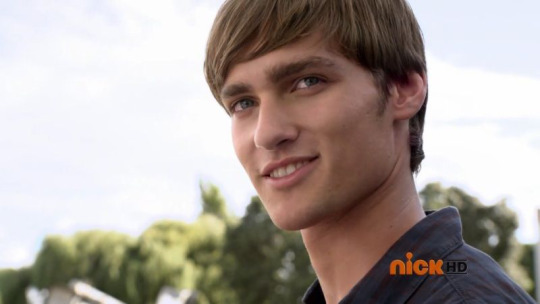
As a Red Ranger, Jayden is a bit of a mixed bag. I like how Alex Heartman gives more of a relaxed performance around the others, showing he can be open, but is more than capable of playing the role of the serious leader. He's somewhat friendly, but when faced with the slightest challenge, he won't hesitate to jump into action, a trait that is put in a new light with a reveal late into the series. “Day Off” is an episode that really shows off his acting chops, as you can really see the struggle Jayden goes through trying to master a new technique.
At the same time, he also doubts his skills more than most Red Rangers, even his predecessor, Scott from RPM. He worries about the good of the team, and will go off on his own if it means they'll be safe... even though he's the one to talk about the importance of working as a team in the first place. This is the biggest problem I have with Jayden as a character. Some episodes, he's the one who tries to rally the team together and does a decent job at it, but other times, he'll abandon them if his ideals are challenged in the slightest.
I feel like making Jayden more friendly also messes with some of the moments where he tries to be more aloof, but I don't mind what this show does with the character. He's nowhere near my favorite Red Ranger, but he's still a serviceable lead.
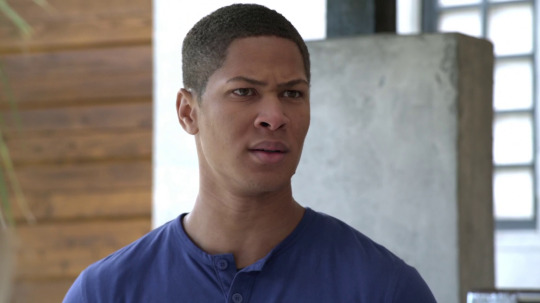
Kevin is arguably more dedicated to the cause than Jayden is and gets more development as the series goes on. Before the Nighlok attacked, Kevin had dreams of being an Olympic swimmer, and he had to give it all up to fight for the greater good. He's so dedicated that he doesn't hesitate to find ways to keep training. When the Rangers get a day off in “Day Off” (I know, shocking, right?), Kevin's first thought that it was a test of their loyalty because “A samurai never takes a day off”, and while he's bedridden after several injuries in “Jayden's Challenge”, he spends his time coming up with a new Megazord combination instead of just resting. In a way, it's like he wants to put as much effort into this role as possible after giving up his dream, and it's why he has the most traditional views on being a samurai.
Most of Kevin's focus episodes revolve around testing his will as a samurai, whether it be finding a Zord to heal the Rangers with in “A Fish Out of Water”, growing to accept Antonio to the team in spite of his differences in “The Blue and the Gold”, and struggling to accept the fact that he had to abandon his swimming career to fight as a Ranger. Granted, that last example is kind of muddled by how the episode ended with Kevin subbing in for someone on his old swim team, but I digress. He honestly goes through the most development of everyone on the team, still maintaining the high standards he puts on himself, but still finds ways to open up to the others more. Overall, a decent character in my opinion.
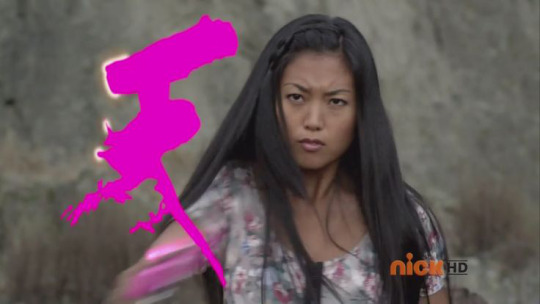
I'm probably going to get accusations of copying what Linkara said during his review of this season, but Mia is honestly my least favorite character in the team. While she's compassionate and tries to serve as the heart of the team, more often than not, you can boil her character down to “likes to cook, even though she's bad at it”. So many episodes mention Mia's inability to cook, and even when a Nighlok with the ability to hurt people with his insults points it out, nobody ever flat out tells her how they feel, instead choosing to make quips about how bad she is at cooking behind her back. Because that's a good lesson to teach kids, right? They don't even do anything funny like exaggerate how terrible her food tastes. There could have been a really nice episode where Antonio tries to give her some advice on how to improve her cooking, given that he's no stranger to food himself.
She also has a bit of a rivalry with Dayu, which I'll get to later, but other than that, she arguably gets the least amount of focus out of the cast. Most of her major roles in Super Samurai basically involve her being the target of Spike's affection, but that never goes anywhere. The only episode she gets that really focuses on her is “He Ain't Heavy Metal, He's My Brother”, and even then, it focused more on her relationship with her brother Terry. The conflict of the episode revolved around Terry starting a rock band while his family tried to get him to focus more on getting into medical school. Instead of actually supporting his dreams and being happy he can do what he wants since she's in a different position being forced into life as a Ranger, she decides to tell him to “be realistic” and blows him off for most of the episode. You would think this would be a conflict where Mia helps her brother achieve his dream, but instead, she just repeats what she was taught since she was a child, only instead of being forced to be Ranger, she tells Terry that he has to be a doctor. To be fair, she does come along, but the episode never draws any comparison between their lives, which is a real wasted opportunity.
In general, this season just brushes over the idea of the Rangers being trained for this mission since birth, not really going into how unethical this can be. I wouldn't outright call them child soldiers, but the writers honestly needed to have more moments where the Rangers talked about how their lives have been, especially in comparison to someone like Antonio. A really interesting idea you could have done with the cooking gag was to show how strict the regimen was for the Rangers growing up. Imagine if out of all the Rangers, Mia is the only one who has almost no life skills outside of being a samurai? Show her struggling to cook a basic meal or even drive a car because she was focused so much on training, being a samurai is the only thing she's good at. But no, instead, we got easily one of the most boring Pink Rangers in the history of the franchise.
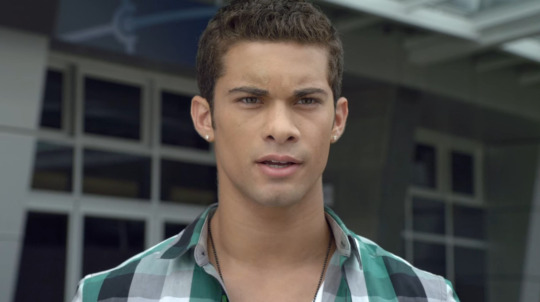
Mike is another character I have conflicting feelings on. Hector David Jr. gives a good performance showing how easygoing Mike can be at times, making him out to be a really chill guy to hang out with. The problem lies in how the focus episodes highlighting how “lazy” he can be don't really work because Mike is never shown to be behind any of the other Rangers in battle. My best guess is that the reason Mike tries to outsmart his opponents more than the others is because he's aware he isn't the best fighter, and needs to resort to trickery more, sort of like what he did in the cold open to “A Sticky Situation”.
But again, as creative as his fight scenes can be, he isn't really shown to be any less competent than any of the other Rangers. I feel like if you wanted to show Mike as the outlier of the team, maybe the writers could have made him be the one who comes into conflict with Jayden's leadership the most due to having arguably the least amount of dedication to the cause compared to the others. Have him be the one to question why he got roped into a war he never wanted to fight because he happens to be the descendant of a samurai, or call out Mentor Ji for not immediately accepting Antonio into the team because he isn't a descendant of a samurai. Basically, make Mike a cynic who isn't afraid to talk back to Jayden, but at the same time, begrudgingly places his trust in him because he's aware that Jayden is still a good leader for all the problems he has with this whole situation. I'm not saying I hate Mike, as I still enjoy his character. I just feel like out of all the Rangers this season, you could have done so much more with him.
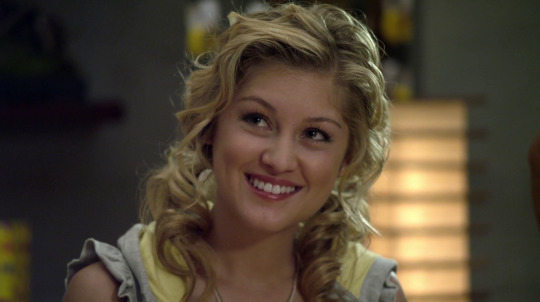
Emily is honestly my favorite Ranger this season. The idea of her not being the first choice for the Yellow Ranger on top of having a lot of self-confidence issues leads to some really interesting focus episodes. Yeah, she can be clumsy and has a habit of needing to be helped, but she isn't really shown to be less capable than the rest of the Rangers. Like Mike, she can be very clever when the situation calls for it, like in (Sticks & Stones, Trading Places, A Strange Case of the Munchies). At the same time, the others tend to act like she's less of a Ranger due to her vulnerability, so she has to prove herself in response. Just because she appears to be harmless, it doesn't mean she's a complete coward or liability in the battlefield.
The one problem I have with Emily is how her backstory is handled. It's a minor nitpick, but I think it would have been a little more interesting if we got to know Emily's sister, Serena, a little more outside of a single flashback. Maybe there could be an episode where Emily goes to visit Serena and tells her about her adventures as a Ranger and see how their relationship could change as a result of years of training for Serena amounting to nothing. There's also a huge plot twist later on that really could have been used in comparison to Emily's backstory, but the show never acknowledged the connection.
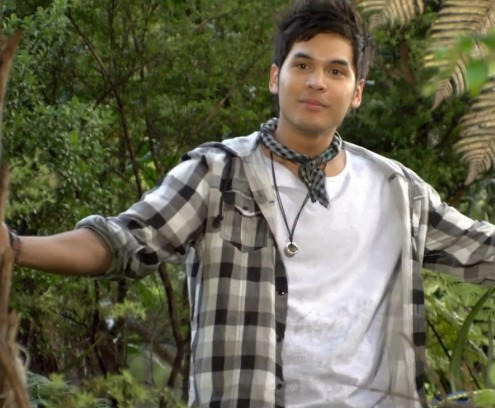
Ironically, Antonio gets the silver medal as my second favorite member of the team. He's full of energy, genuinely wants to help people, and his friendship with Jayden is very believable. The fact that he managed to barge into the team by reverse engineering Zord technology and helped them unlock several new upgrades as a result of his skills with technology makes him stand out from the traditional setup we all came to expect for the first half of Samurai. At the same time, his overbearing nature makes it easy for others to underestimate him, like in “Room for One More” and “The Blue and the Gold”.
Generally, Antonio's computer knowledge helps one of the underlying themes of this show, finding new ways to work with tradition. It's because of him that the Rangers gain access to forms and weapons that none of their predecessors had access to. While Kevin and Mentor Ji initially struggle to accept Antonio into the team thanks to his use of technology and unorthodox fighting style, they realize that he is just as much of a samurai as the others are. For a show focused on bloodlines and destiny, Antonio's introduction was surprisingly well-done, and it adds to the appeal of his character.
As for the allies, we only have three: Mentor Ji, Bulk, and Spike.

Mentor Ji is honestly a pretty forgettable mentor, all things considered. The Rangers already spent their entire lives training, so why is he even there? We don't get a lot of scenes where he helps them train, and unlike other mentors like Master Splinter or Sensei Wu, he doesn't get to help the Rangers on the field as much as he should. Yeah, he doesn't have powers, but he's still shown to be a pretty capable fighter regardless. He just doesn't have as commanding of a presence that a mentor has compared to Zordon, Doggie Cruger, or Doctor K.
The most we really know about his past is that he pretty much raised Jayden since he was a kid, and that he has a motorcycle (implying he was a rebel in the past), and that's it. We never see how deep his relationship with Jayden goes despite being the only one to know an important secret the latter has. For the most part, he serves more as a yes-man for Jayden who occasionally scolds the other Rangers. Even Gosei was memorable for how boring he was and how he gave his Rangers power-ups every day, but Mentor Ji? I still can't really tell you much about his personality other than that he's strict.
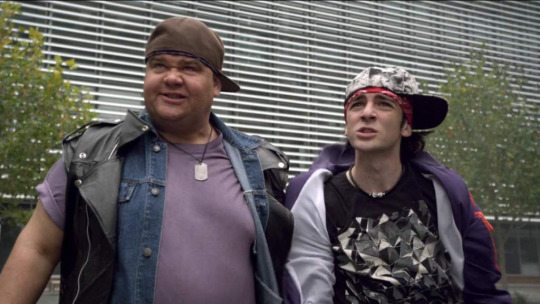
It's pretty clear that the return of Bulk was meant to be a selling point for older fans who hated the way the Zordon Era had been forgotten by Disney, but the problem I have lies more in how not much is done to draw connections to older seasons, and even the plot for this season. Remember, this was the first season of Power Rangers I ever saw as a kid, and thanks to the incompetence at Nickelodeon preventing me from seeing the actual pilot until the first half was over, I never got a proper introduction to Bulk. Even “Origins” just casually has him mention that has a history with the Power Rangers, but he doesn't say much beyond that.
With Tommy's reintroduction in Dino Thunder, more emphasis was placed on how important of a character he was in the franchise, and how much of a surprise it was for the new team to find this out. With Bulk and Spike, you could easily replace them with any other two characters, and not much would change. You could have had made all kinds of jokes with Bulk having lived through so many monster attacks, like have him note that samurai-themed Power Rangers is a surprise, or that he's not even surprised by monster attacks at this point. I know Linkara made this a joke in his video, but you could have had a funny running gag where Bulk goes off on tangents about things that actually happened to him, like the time he and Skull got turned into monkeys, only for Spike to brush him off due to how ridiculous they sound.
Another thing I don't get is why Bulk suddenly wants to be a samurai. I mean, it's not completely out of the ballpark, considering he and Skull pretty became police officers on a whim, but at least there, it was established that they did it to attract girls. Here, it's never explained what made Bulk want to become a samurai, much less train Spike to be one too. He said that he's watched a lot of samurai movies in “Origins” (meaning that Bulk is canonically an Akira Kurosawa fan), and another line right after that slightly implies that he was inspired by the appearance of the Samurai Rangers, but there's not much of an explanation beyond that. I just think if you wanted to make this the main focus of their plotlines, there should be more of an explanation behind Bulk's sudden interest in samurai culture, and that he and Spike should actually get to spend time with the Rangers. Most of the time, they just do their own thing that's vaguely related to being a samurai or wanting to help people, and it feels like you're watching an entirely different show. Even in Mighty Morphin, Bulk and Skull regularly interacted with the Rangers in their civilian lives like supporting characters should, but they don't start to talk with the Rangers in person until Super Samurai.
That being said, Bulk and Spike's antics are still pretty fun to watch. I like the idea of Bulk being this exasperated uncle to someone like Spike, and while I have some problems with the motivation, it's nice to see Bulk take Spike under his wing and teach him about the code of honor a samurai has. Yeah, he still sees being a samurai in a superficial light at times, but at the same time, he still encourages Spike to do the right thing with no ulterior motive, like attempt to fight the Nighlok themselves in a few episodes (Sticks & Stones, Test of the Leader, Stroke of Fate). You can tell that Bulk wants the best his nephew, and when Skull (once again played by Jason Narvy) makes a cameo in the final episode, he's grateful that Bulk watched over Spike.
Spike himself is a decently written character. He's hyperactive and has a laugh that SpongeBob SquarePants would find annoying, but he very clearly wants to help people. I honestly think the show would have been more interesting if the subplots with Bulk were building up to Spike creating his own Morpher and becoming the Gold Ranger instead of Antonio, because Spike clearly has the heart of a Ranger.
Overall, this was a pretty okay cast. There were some who were more memorable than others, but I never outright hated anyone. The Samurai Rangers in particular are a lot more memorable than future Neo-Saban teams like the Megaforce Rangers or the Ninja Steel Rangers.
THEIR ARSENAL
The Samurai Rangers morph using the Samuraizer, a cellphone capable of utilizing Symbol Power. Since this is the source of their powers, they can do things with it other than transform, like create elemental attacks, access their Megazord, and pretty much do whatever the plot needs them to do. Unlike Shinkenger, the Samuraizer doesn't transform into a brush while in use, which is kind of weird, since it makes the Rangers look stupid waving their flip phones in the air. Even Antonio's Morpher, the Samurai Morpher (real creative name, fellas), doesn't resemble sushi like its Sentai counterpart, and looks like a more modern take on the Samuraizer. Either way, it's still a weird change to make, especially since another character just uses the same kind of Morpher the Shinkengers used anyway.
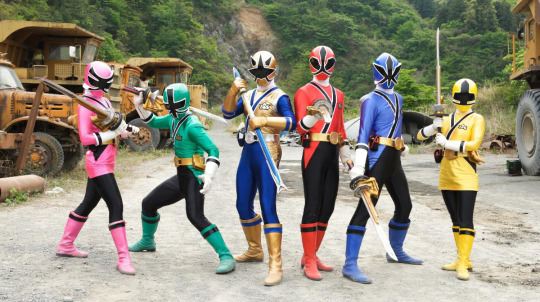
I really like the design of the Samurai Ranger suits. There's a nice balance of black and their respective colors, and the symbols on their helmets are unique. The way their suits are designed after samurai robes is also a nice touch.
The core five Rangers' primary weapon is the Spin Sword, a standard samurai sword with the ability to use different elemental attacks depending on the use of a Power Disk. The Spin Swords can also transform into each Ranger's signature weapon. Jayden gets the Fire Smasher, a giant sword that can transform into a cannon to fire disks with, Kevin gets the Hydro Bow, a bow that can fire off energy arrows, Mia gets the Sky Fan, a fan that can create gusts of wind, Kevin gets the Forest Spear, a spear capable of extending to serve as a pole vault, Emily gets the Earth Slicer, a giant shuriken that can be thrown like a boomerang.
Instead of a Spin Sword, Antonio gets the Barracuda Blade, a backhanded sword that he can use to attack enemies at high speeds, something none of the other Rangers can do. In Super Samurai, Antonio gets another weapon in the form of the Lightzord, a lantern capable of shooting disks that comes with a sword, and can even form its own Megazord.
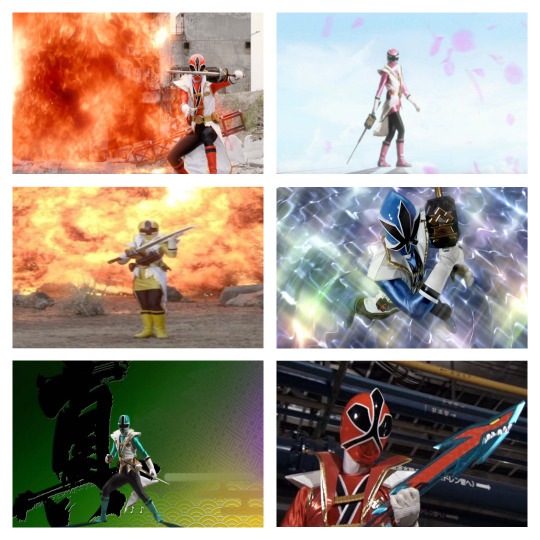
Speaking of Super Samurai, once Antonio unlocks the full power of the Black Box, the core five Rangers are able to access Super Samurai Mode, a pretty elegant-looking new form which boosts their elemental powers and gives them the ability to access more Megazord combinations, but can only be used one at a time. Jayden in particular gets a new weapon to go with his Super Samurai Mode, the Bullzooka, a blaster that can be combined with the Spin Sword. They also get one more mode, Shark Attack Mode, which gives the user a red version of the Super Mode and a sword that stretch around like crazy.
Overall, this is a pretty solid arsenal. There's plenty of variety to what the Rangers can do, but it doesn't feel too overwhelming to keep up with. They saved that for the Zords.

The core five Samurai Rangers have a Folding Zord, these tiny shapes that can grow and resemble animals to fight giant Nighlok with. Jayden gets a pentagon/lion, Kevin a hexagon/dragon, Mia a circle/turtle, Mike a square/bear, and Emily a triangle/monkey. These five Zords combine to form the Samurai Megazord.
While it's a little blocky, I really like the design for the Samurai Megazord. The sword and helmet really make it stand out among other base Megazords, and I think the basic finisher, Katana Power is one of the coolest attacks in the entire series.
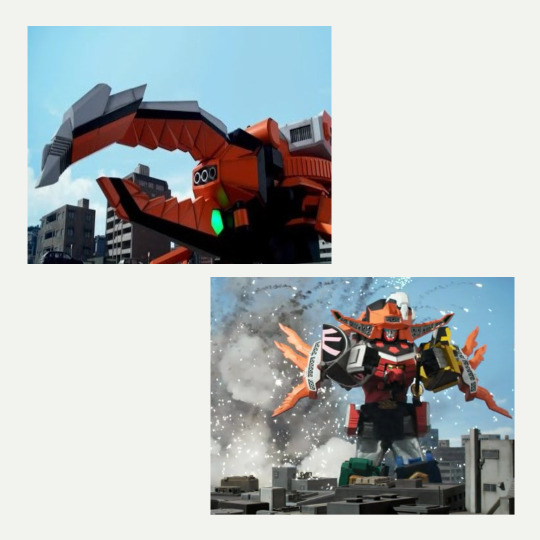
The rest of the Zords are themed around the various disks the Rangers use. The Beetle Zord is the first auxiliary Zord Jayden unlocks (though he later hands it down to Mike), and it can combine with the Samurai Megarord to form the Beetle Blaster Megazord, with the ability to fire energy blasts from its helmet.
It's a pretty simple looking upgrade, but I dig it. I especially like the finisher, Rotating Beetle Blaster, where the beetle head spins around and shoots a huge fireball.

Kevin's auxiliary Zord is the Swordfish Zord, which can fly around in addition to swimming, be used to cure any poison, and can even shoot torpedoes at enemies. Wow, this is a really solid Zord, so surely, the Megazord combination should be really cool, right? Well...
Because a majority of the Swordfish Zord is on the back, the Swordfish Fencer Megazord doesn't look that impressive, and is one of the combinations that sees the least action. It doesn't help that the finisher where he sticks its sword in its head and swings it down looks ridiculous.
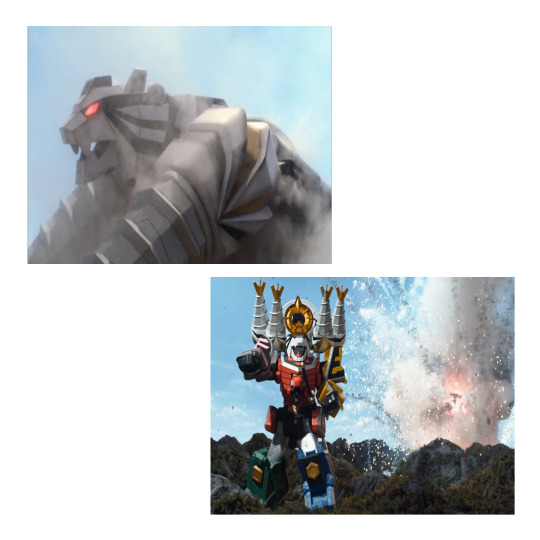
The final member of the original three auxiliary Zords is the Tiger Zord, which Jayden unlocks. It doesn't really get to do a lot on its own, and mainly serves as a centerpiece for the other Megazord combinations.
The Tiger Drill Megazord, a Megazord which can drill through enemies, isn't that impressive, though I feel like it's more because it doesn't get to do much compared to its other combinations.
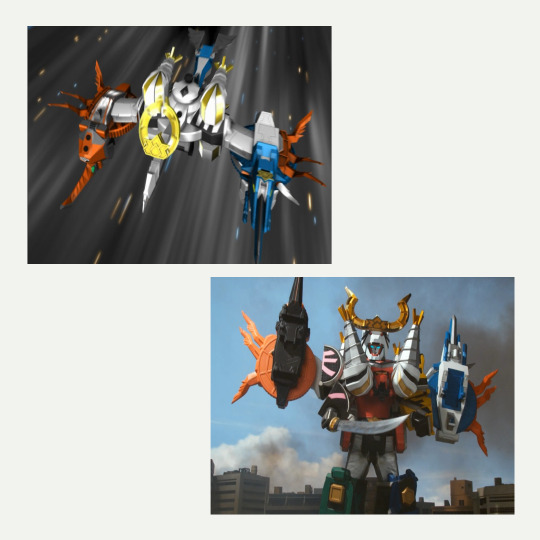
The Beetle, Swordfish, and Tiger Zords can all combine into the Samurai Battlewing, which in turn, can combine with the Samurai Megazord to form the Battlewing Megazord. All things considered, I think this is one of my favorite combinations in the series, because there's a good balance between all eight Zords combined, and giving it the ability to fly helps it stand out.

Antonio's first Zord is the Octo Zord, which naturally, looks like a giant squid.
What? Octopus, squid, they're the same thing, right? This Zord can combine with the Samurai Megazord to form the Octo Spear Megazord, giving it a freeze ray and an electric lance.
It's simple, but I like the way the Octo Zord forms all these weapons for the Megazord.
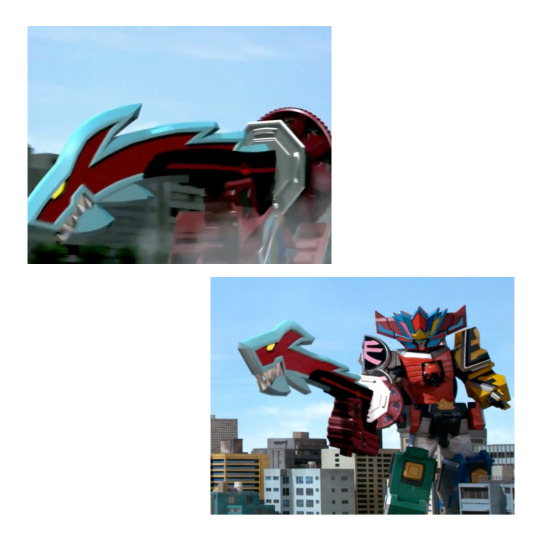
One last auxiliary Zord that only really appears twice, but is still worth mentioning, is the Shark Zord, basically a giant version of the Shark Sword in Shark Attack Mode.
It can combine with the Samurai Megazord to form the Samurai Shark Megazord, using the Shark as a giant sword.
Not much else I can say there, other than that it exists.
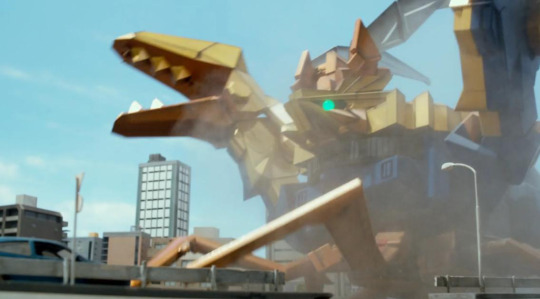

Antonio's primary Zord is the Claw Zord, a lobster that can transform into the Claw Battlezord. Unlike most Megazords, it has four different modes based off what head it has. East is the default mode that can weaponize the Zord's claws, South uses twin katanas, West has a fan for a weapon, and North is the only mode that can combine with the Octo Zord, using it as a giant spear.
Once the Rangers unlock the power of the Black Box, they can combine the Samurai Megazord and Claw Battlezord to form the Claw Armor Megazord, while the Beetle, Swordfish, Tiger, and Octo Zords can combine to form the Samurai Battle Cannon.
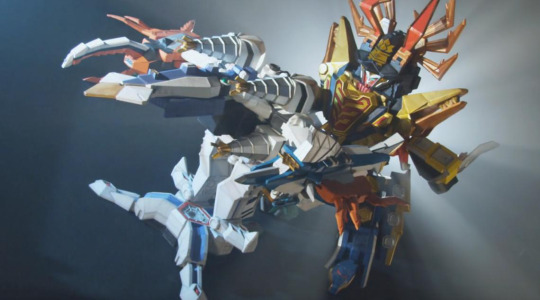
While I think the cannon looks cool, the Claw Armor Megazord is pretty disappointing. It just looks like the Claw Battlezord with the Samurai Megazord's legs with the Turtle and Ape being reduced to sword holders.
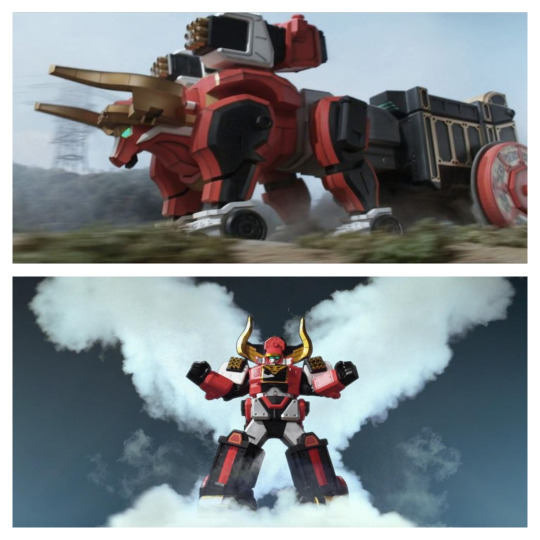
The last Zord the Rangers unlock is the Bull Zord, a giant bull armed with cannons, and can transform into the creatively named Bull Megazord.
I really like how the design for this Megazord emphasizes the strength of the animal it’s based on, as well as the focus on ranged attacks. All eleven Zords can combine to form the Samurai Gigazord.
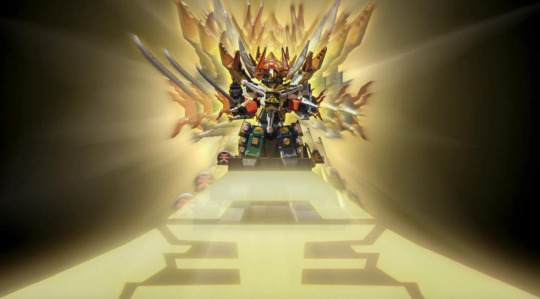
To say I'm not a fan of this combination would be an understatement. So many Zord parts just look like they were stuck on somewhere because the designers didn't know where else to put them, like the Samurai Battlewing on the back, or the Turtle and Ape Zords at the bottom.
Overall, there are a lot of cool Zords in the Rangers' arsenal, and the only real problems I have lie in the last two major combinations. Well, those and the dreaded Megazord cockpit forms, which would be common for most of the Neo-Saban seasons.
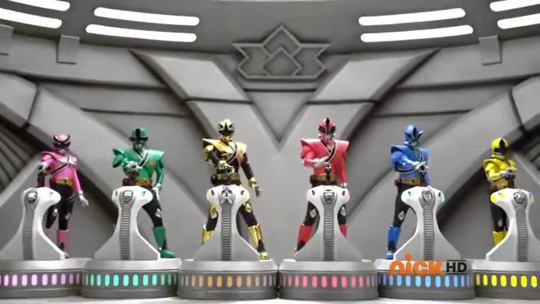
In order to access their Megazords, the Rangers transform into Mega Mode, and their Spin Swords become Mega Blades, which can be used to control the Megazord... when it's never explained why they need to use this form in the first place. Yeah, this franchise is no stranger to promoting toys, but why spend this much money on a form that adds nothing to the team's arsenal? This season has already gotten a lot of flak for just copying Shinkenger's story, so a lot of the Mega Mode scenes could have easily been cut to focus more on original fight scenes.
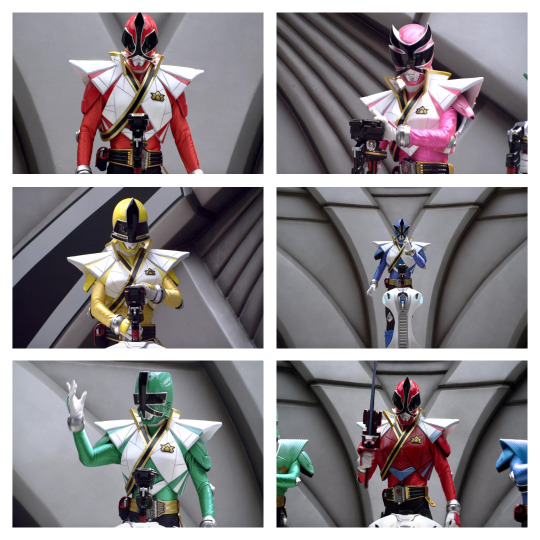
And it gets worse. The super modes have a Mega form too, and they're just as pointless. There's not much I can say other than the Super Mode vest gives them more armor, but I don't see the point of giving them more armor when they're not fighting a Nighlok head on. You could have easily said something like this form is necessary because a lot of Symbol Power is needed to control the Megazords, and this form is the safest way to channel it in a high amount. But instead, there's never any real explanation for this form.

And that's not even getting into Shogun Mode. After Jayden unlocks the Bull Zord, a Ranger in Super Mega Mode can access Shogun Mode right before the Megazord's finisher... and nothing changes. You could at least argue it's necessary for the Bull Megazord and Samurai Gigazord, but then Mia goes Shogun Mode in a later episode to use the Samurai Battle Cannon with no changes. They don't even try to edit the finisher to make Shogun Mode seem more powerful.
The only time any of these forms get action outside of the Megazord cockpit is in the finale, when Jayden can suddenly use Shogun Mode, but it's not explained why he can do that. Later seasons with original Megazord cockpit scenes and Megazord cockpit modes would at least use the footage to get more creative with the setting by involving characters who weren't involved in the Sentai originally, like in Dino Charge and Dino Fury. As a whole, these forms just don't add much to the arsenal or story compared to later entries.
THE VILLAINS
While I think these villains have an interesting idea behind them as a whole, the Nighlok as characters really leave a lot to be desired.

Coming off the heels of Venjix, arguably one of the scariest and most successful villains in the franchise, to say Master Xandred is a letdown would be an understatement. We're supposed to see him as this unstoppable demon lord, when most of his screentime consists of him sitting around and drinking booze—I MEAN MEDICINE. THIS IS OBVIOUSLY HEADACHE MEDICINE HE IS DRINKING. When he's not slacking off, he's just yelling at his subordinates for breathing wrong, all while it's impossible to take him seriously when he sounds like someone doing the world's worst Alex Jones impression. Yeah, he's shown to be pretty damn strong when he's on the surface, beating up the Rangers with ease while he's weak from Sanzu River dehydration, but there isn't really a lot of emotional drama or connection to him on the Rangers' front. The show doesn't go into detail about how brutal the war has been over the years, and even the idea of Jayden's father being the person who sealed him away originally doesn't really change how he sees Jayden, or any of the other Rangers for that matter.
I just feel like if you wanted to show how strong he was, have him fight the Rangers earlier in the series to give the audience an idea of how deadly he is, long before the Rangers even get the Black Box or any of their other Megazord combinations. It would put more incentive for the Rangers to get more upgrades instead of his growing power doing nothing but occasionally sending out hordes of footsoldiers. There's actually another villain who really should have taken his place as the leader of the Nighlok, but I'll get to him later.

Octoroo is arguably the second most competent of the Nighlok, and the most loyal to Master Xandred. He actually comes up with plans that would benefit his kind in the long term, like targeting Jayden to make sure he doesn't use the sealing symbol (Unexpected Arrival, Fight Fire With Fire), trying to refill an old gate with Sanzu River water for the Nighlok to travel through (The Blue and the Gold), and risking his life to power up a Nighlok to create extra misery before they get sealed away for good (The Great Duel). Of course, all Master Xandred does is, as I mentioned before, yell at the only one of his generals to not betray him in some way because he's a really stupid demon lord. I think it would have been interesting for something to happen that would test Octoroo's loyalty to Master Xandred, or at the very least, expand upon their relationship in some way.

Dayu is honestly a pretty interesting character, mainly due to the way her backstory was handled compared to Shinkenger. Without giving too much away on either side, Dayu is much more sympathetic than her Eastern counterpart, and it also connects her to Deker in an interesting way by making her half-human as well. The way her instrument (it's called a harmonium, but it looks and sounds nothing like one) is connected to her backstory gives her a much more tragic element to her, and when it's broken by Master Xandred, not only is it enough for her to leave the Nighlok out of spite, her desperation to get it fixed is given greater meaning because of how much it means to her past. She's been through so much, and her instrument is the only thing she has that can remind her of her past, when she was far happier, but it's shown to be a very self-destructive lifestyle.
She's so dependent on reliving her past where she was about to start a happy life with her loved one, she's willing to go back to Master Xandred if it means she can get it fixed, and as soon as the reality that her loved one is gone sets in on her, she feels like she has no choice but to give into her Nighlok side and help Master Xandred reach the surface. It's a pretty tragic character arc, all things considered, and I feel like the changes made from the Sentai really help to make her stand out.
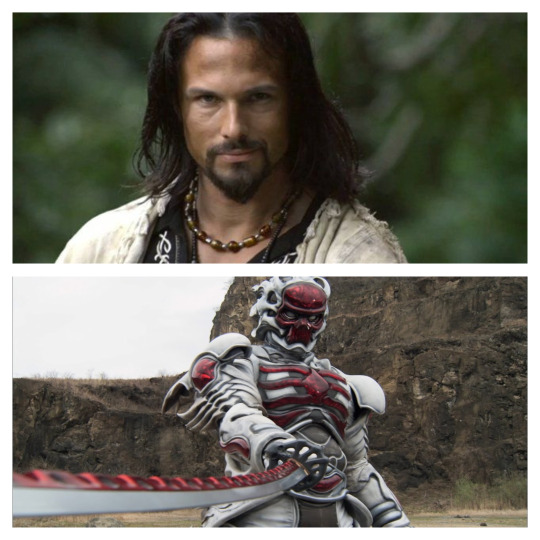
Unfortunately, I can't say the same for Deker. Despite being billed as Jayden's main rival, Deker doesn't really have a lot going for him other than his backstory and how often he likes to talk about his sword, Uramasa. And don't worry, he says it all the time so you don't forget the name. Again, without spoiling Shinkenger for newcomers, Deker's Sentai counterpart is arguably more deranged than even Dayu's, and the problem here is that this show wants to have the best of both worlds with Deker as a villain. The writers clearly want him to be held in the same level of disdain as even Master Xandred, but also want him to be a more sympathetic villain. I'm not saying you can't do that, but even with Zen-Aku, he did plenty of evil things before we learned he was cursed.
With Deker, the show spends so much time trying to remind the audience of how tragic of a figure he is, they forget to have him actually do anything evil to balance that out. Yeah, he interrupts a Nighlok fight to duel Jayden (Test of the Leader), but he never really does anything else like that. The closest he comes to being evil is when he temporarily operates under Serrator's faction, and even then, it's so he can get Uramasa fixed. When he fights, all he talks about is how he wants to break his curse, but we never see him go to any extreme measures to break the curse. Instead of a noble demon, show Deker as someone who will threaten Jayden into dueling him so he can break his curse, and resort to dirty tactics so he can find a way, any way to break the curse. He's lived for over a century, but he never really shows any desperation or drive to end his misery like what we see with Dayu. It ultimately makes it hard to get invested in his final duel with Jayden because he's not too big of a threat who needs to be stopped like Jayden claims.
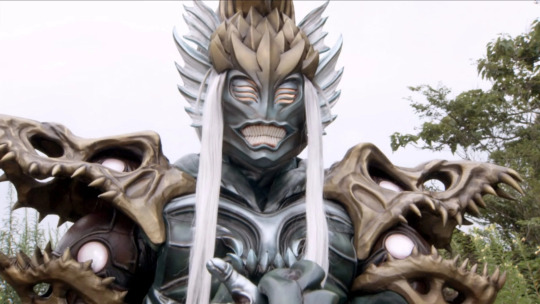
Again, not to parrot Linkara's views on the show, but Serrator really should have been the final villain. He's easily the most deceptive, has a bigger role in the backstories of Deker and Dayu, and he has a bigger plan in general. You'd be forgiven for thinking that Master Xandred was a red herring and that he only existed as a placeholder until Serrator took over. He has a much more unique arsenal of soccer balls, giant bladed gauntlets, and even his own personal footsoldiers, showing how he is able to keep up with the Rangers on his own. The fact that he almost came close to achieving his goal only serves to show how effective of a villain he was.
You could have easily changed the story for Serrator to take over. Show how weak and pathetic Master Xandred has become after generations of battles with the Samurai Rangers, and the first time the current generation of Rangers sees him surface, he isn't this threatening juggernaut they were taught to see him as. Instead, Serrator kills him and asserts himself as the true master of the Nighlok, throwing the Rangers through a loop as he plans to do something worse than flooding the Earth with the Sanzu River. Unfortunately, we’re stuck with Master Xandred instead.
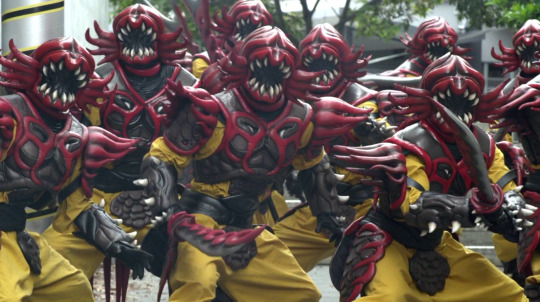
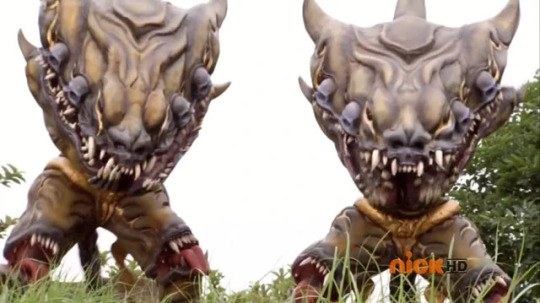
The Nighlok's footsoldiers, the Moogers, have some pretty cool designs. I like the demonic look to them, and they have a pretty cool arsenal. They also get giant variants to fight the Rangers with in their Megazords, alongside the Spitfangs, these walking crocodile heads that can breathe fire.

The standard Nighlok monsters also have some unique designs to them, as well as some really cool powers that show a noticeable flaw in the Rangers' training. Because the Rangers are trained to be samurai, they struggle against Nighlok they can't match in sword combat. There are Nighlok like Rofer, who can extend his arms to punch enemies, Dreadhead, who is immune to sword strikes, Madimot, who can brainwash people, Steeleto, who can manipulate the blades on his body to attack enemies, Armadeevil, who has a near impenetrable shell, and Maldan, who leads a squadron of Moogers armed with laser blasters.
A lot of these Nighloks are pretty intimidating, and thanks to their abilities, prove to be a real challenge to the Rangers, which makes them finding ways to beat them all the more cathartic. If I had to pick my favorite, it would either be Dreadhead for his entertaining cowboy voice, or Robtish for his design.
Overall, these villains can be very hit and miss. While they're far from the worst villain group in the franchise, there was a lot of room for improvement.
HIGHLIGHTS
Top Five Worst Episodes
#5: Boxed In
After being poisoned by Octoroo, Jayden is abducted by Deker while the other Rangers are injured by the treacherous Nighlok, Arachnitor. So not only does Antonio have to continue working on unlocking the power of the Black Box, he also has to find Jayden, while the rest of the Rangers have to fight against Arachnitor, who had recently been mutated by Master Xandred.
This episode isn't necessarily bad, but the problem lies in how it tries to extend the Black Box arc for Super Samurai. With the way its set up, you would think Antonio borrowing the other Rangers' Power Disks would mean he would make more progress on the Black Box, but then it never comes into play during the climax. The Rangers don't even beat Arachnitor, as he just gets away while they say that he did multiple times to make sure the audience knows.
The Megazord fight at the end with the Giant Moogers is just poorly edited, blatantly reusing footage from earlier and future episodes that doesn't even match up with the current events, like Jayden's control panel having the Beetle Zord emblem when he gave it to Mike a while ago, Antonio's cockpit showing the Claw Battlezord is in South mode when it stayed in East for the entire battle, or having Claw Battlezord East's finisher lead to the footage of Giant Moogers being taken down by the Claw Armor Megazord's Double Katana Strike in “Super Samurai”.
As a whole, the episode just feels like padding because nothing is really accomplished other than a little more knowledge on Deker's backstory, and this leads to the fight scenes in the next two episodes being heavily edited thanks to the Rangers not having the Black Box yet. It's at the bottom of the list because its flaws are more in how the writers chose to handle the Black Box in general by dragging out the debut.
#4: The Blue and the Gold
While trying to adjust to his new life with the team, Antonio starts to spy Kevin to find a way to understand him better, the two accidentally uncover a Nighlok plan to refill an old well with Sanzu River water so they can use it as a portal. In addition to Octoroo's barrier blocking their cell signal, his accomplice, Antberry, uses his Sanzu Slime to make it hard for them to actually use their weapons. Kevin and Antonio have to put aside their differences and find a way to deal with the Nighlok without the help of the other Rangers.
Like “Boxed In”, this episode isn't really bad, as it's some good character focus for Kevin and Antonio, and hearing Octoroo say “The Red Ranger's gonna fry your boo-tay!” near the end was pretty funny. The problem lies in how it adapted the Shinkenger plot. In the corresponding Shinkenger episode, the villain's plan was still to use a well as a portal for his kind, but he planned to sacrifice several schoolgirls to do so. How does Saban handle this? Their plan is to break a bunch of stolen toys. I am not making this up.
Okay... first, how would breaking toys cause a lot of sorrow if the kids who owned them aren't around to see them being broken? Second, how does the axe Octoroo gave Antberry work, and why does it need to be used to break toys instead of any old weapon? Third, why does the axe need to be sharpened if it's only being used to break some plastic toys? Fourth, why would Octoroo recruit a Nighlok with the most conspicuous powers for a covert operation? And finally, why was stealing toys from kids to cause sorrow “Plan A”?
The whole story just has so many plotholes, and the idea of stealing toys just makes the Nighlok look inept instead of the fearsome demons the show wants us to see them as.
#3: A Sticky Situation
Epoxar, a Nighlok with glue powers, glues both Mike and Kevin's hands together, making it hard for them to actually fight. When the other Rangers are incapacitated by the Nighlok, it's up to Mike and Kevin to put aside their differences and take down Epoxar.
I'm not a fan of the “two characters get glued together” plot a lot of TV shows do, so as you can imagine, I'm obviously not a fan of this episode, and most of it boils down to how the story is handled. First off, the Rangers only try to get rid of the glue once, by having Jayden swing his sword at the makeshift handcuffs. Nobody tries using their Symbol Power to melt the glue or maybe make it easier to stretch a little. Second, both Mike and Kevin think that they can work together while stuck like this, and the scenes of them trying to train in this state just drag on. Third, even though they know what the Nighlok's powers are, the Rangers don't even think to be careful while chasing him, and fall victim to his glue trap.
This episode is just full of poor decisions, and it isn't even that funny. It doesn't help that this was the last filler episode before the final two arcs, and it was a pretty bad filler episode at that. Also, there was a scene where Kevin had go to the bathroom while he and Mike were still stuck together, and now all I can't get that horrible image out of my head.
#2: The Great Duel
While the Rangers get used to a new addition to their ranks, Jayden faces off against Deker for the final time.
I don't want to give too much away, given that this episode is during the final arc and involves a new character, but a lot of the problems I have with the episode boils down to how this new character is treated by the other Rangers. They don't really do anything wrong, yet all the other Rangers do is judge them for no reason.
Another problem I have lies with Jayden's final duel with Deker. Like I said earlier, there's no real drama between the two that makes you get excited for this fight, and what should be an important moment for Jayden's character arc just comes across as filler.
It's just not a good episode because even though we're this close to the end of the series, nothing really feels important here.
#1: Something Fishy
After he was almost eaten by a cat while he was in the body of a fish in the previous episode (I'll explain later), Antonio develops a crippling fear of fish to the point where he can't even draw his Barracuda Blade. When it seems like the Rangers can't snap him out of his fear, they go to face Serrator for the first time, while Mentor Ji tries to help Antonio find a new weapon to use.
While I like the idea of a Ranger having to deal with the trauma of a monster attack, the way it's handled just doesn't work. It's framed as a standard “face your fears” episode while not really acknowledging what caused Antonio to develop a fear of fish: association with a negative incident. Most of the team's attempts to help Antonio amount to “I'm going to force myself to do something I don't like so you can eat fish and overcome your fear”, and before that, they pretty much tell him to grow a pair and get over it.
In general, Antonio's fear is treated as unreasonable and even the way it's resolved feels like an insult to anyone who struggles to face their fears. Mentor Ji just goes up to Antonio, shoves a piece of sushi in his mouth and tells him to just deal with his crippling fear of fish that he only got after a near-death experience.
This could have been a great character focus episode for Antonio. You could have explored why he chose to follow his father and become a fisherman himself instead of what we got. And the worst part is with the debut of Serrator and the Light Zord, this episode is very relevant to the plot. They seriously made an episode where a major villain debuts at the same time as an annoying subplot that fails to actually explore fear, and that's just one of the reasons why I think this is the worst episode of the season.
Top 5 Best Episodes
#5: Super Samurai
When Arachnitor returns and overwhelms the Rangers, Antonio has to hurry and finish the Black Box as soon as he can and give the team the power boost they need, all while water from the Sanzu River starts to seep into the human world.
While I had a lot of problems with how the Black Box arc was stretched out so it would start in Super Samurai, this episode honestly does a great job showing off the new powers and setting the stage for the second half of this season. The scene where the Rangers see a puddle of Sanzu River water is seen as bad because we know the Nighlok need it, but the simple image of a stick catching on fire as soon as it's dipped in the water is honestly pretty chilling. It pretty much tells the audience, “You thought the Sanzu River flooding the world was bad? Wait until you see what the water does to anything that isn't a Nighlok.”
The stakes are raised even further when the Rangers encounter Arachnitor, and thanks to Octoroo's meddling, can't morph to fight him or the Moogers. We even see some of Mia's hair get singed thanks to touching some Sanzu River water. It's some pretty tense stuff, which is what makes the Rangers getting their powers back in addition to Jayden's first Super Samurai Mode transformation all the more triumphant.
I also really like the ending where Jayden acknowledges that they'll need to use the Black Box more to keep up with the growing threat of the Nighlok, as it really shows how things have gotten more serious. It's a great way to open up the second half of this season.
#4: Trading Places
Switchbeast, a Nighlok under the command of a mysterious benefactor (later revealed to be Serrator), uses his powers to switch the minds of civilians with everyday objects, including Jayden, Kevin, Mia, and Antonio, so it's up to Mike and Emily to stop on their own.
Body swap episodes are a hallmark of TV shows, especially ones aimed at children, and unlike “A Sticky Situation”, which played the cliche plot straight, this episode tries something different with the body swapping. Instead of the standard conflict of the Rangers needing to get used to each other's powers, the swapped Rangers are taken out of the conflict entirely due to being stuck as inanimate objects, leading to a more character-focused conflict with Mike and Emily being the only ones able to stop it, where earlier episodes just left one Ranger out of commission at a time (Team Spirit, The Great Duel).
Another interesting thing is the way the conflict is treated. When you first think about the plan, it's pretty tame by Nighlok standards. It's not stealing and breaking toys dumb, but it's up there. But then the episode reveals Switchbeast's true plan. Why did he place the minds of random people in inanimate objects? Simple, all so the objects could be taken out and disposed of, killing the people inside while their bodies remain emotionless husks, causing all kinds of sorrow. It's honestly a pretty demented plan, and it makes sense when you remember this Nighlok works for Serrator.
This episode also does a good job showing off how far Mike has come as a character. He and Emily have both been underestimated the most out of the team, and even when Emily brings up the events of an earlier episode where Mike tried taking on a Nighlok by himself, Mike is more focused on the fact that Jayden had to save him at the end. Even when Mentor Ji gives him the Black Box to use, Mike isn't sure if he can handle the power. It's pretty interesting to see Mike doubt himself when the stakes are so high, which only makes his and Emily's eventual triumph over Switchbeast all the more satisfying.
I also have to give credit to the actors who were playing the victims this episode, specifically the scenes where Mike and Emily are talking with Mentor Ji while the others are standing there as inanimate objects. It must have been really hard to keep a straight face, especially Najee De-Tiege when Mike put Kevin in a tutu while standing still as a joke.
It's just a really fun episode with really high stakes.
#3: Runaway Spike
When the rent on Bulk's home is overdue, Spike goes out and tries to get a job to help raise money. Meanwhile, the Rangers have to deal with Duplicator, a Nighlok who can create clones of himself.
Despite being billed as important characters in the opening, Bulk and Spike never really got a lot of focus episodes. Thankfully, that changes here. While this is still a rather lighthearted filler episode, it's a good character study for both Bulk and Spike. Spike generally wants to help his uncle out, and while him screwing up on multiple jobs is played for laughs like you'd expect, we see how it affects his self-esteem to the point where he doesn't even notice Duplicator's first attack due to how down he's feeling. After the attack, Spike vents to Mia (who went to make sure he was okay after Duplicator escaped) about how much of a loser he thinks he is, and it's some pretty engaging stuff.
It's also a great episode for Bulk. When he sets out to look for Spike once it gets dark, it really shows how much he cares for his nephew. He doesn't ramble about any ulterior motive like saying Skull will kill him if anything happens to Spike. He chooses to let Spike go out and get a job on his own, but when it gets late, he decides to go looking for him. It's subtle, but it's a great way to show the level of trust Bulk has for Spike, and when it's hinted that Spike got fired from his last job as a security guard, he tries his best to reassure him that he did his best. I really wish we got more episodes like this that explore the relationship between Bulk and Spike, because the two are great here.
Spike's brief interaction with Mia is the highlight of the episode, as not only is a clever follow-up to the running gag about him falling for the Pink Ranger (like father, like son, am I right?), but it's one of the few scenes where Mia can really shine as a character with her, an actual samurai, telling the samurai-in-training to never give up. While I never really shipped Mia and Spike, I can honestly see the two hanging out and becoming close friends after the events of the series. There was also a real missed opportunity to have Spike be one of the few people to actually enjoy Mia's cooking.
The climax here is also one of the more visually stunning fights in the series, using a lot of shadows and clever lighting. Like Duplicator says about himself multiple times in the episode, it's really cool. It's just a great episode that manages to have a fun monster fight while expanding on the characters of Bulk and Spike.
#2: Unexpected Arrival
Octoroo sends Vulpes, a Nighlok with mirror and illusion spells, to spy on Jayden to learn more about the sealing symbol, while the other Rangers try to investigate a mysterious fisherman who sent a message about seeing them soon.
This is the only episode of Samurai's first half on the list, and oh boy, is it a good one. The first half is full of suspense and intrigue as to what the Nighlok's plan is. There's a real sense of uneasiness, especially with how the Nighlok seems to target Jayden specifically. He becomes so paranoid, he actually comes close to accidentally harming Emily in one scene.
The episode also does a great job at introducing Antonio. With how it's structured, you would initially believe that he's connected to the Nighlok's plan, which makes his appearance as the Gold Ranger just as surprising to see as it is for the other Rangers. Granted, Nickelodeon's promo outright spoiled that Antonio was the Gold Ranger, but it's the thought that counts.
After how uneasy the first half felt, Antonio's debut lightens up the tone and makes it incredibly satisfying to see Vulpes get his ass handed to him while showing how eccentric Antonio can be. At the same time, it sets up the next episode where we learn more about Antonio as a character, introducing him but not giving everything about his backstory yet, making the reveal that he and Jayden are old friends intrigue audiences. The episode featuring the debut of the Gold Ranger clearly lived up to its title, as it was clearly a golden one.
#1: The Strange Case of the Munchies
Jayden, Kevin, Mia, Mike, and Antonio are all afflicted with an insatiable hunger thanks to Grinataur, leaving Emily the only one capable of stopping him and keeping the others in order. Meanwhile, Bulk and Spike find Mia's wallet and try to return it by going to the Rangers' home, only to get roped into “Samurai training” by Emily as a diversion.
This is honestly my favorite episode of Samurai just because of how wacky it can get. The sheer amount of energy put in by the actors as they try to eat whatever they can get their hands on is just hilarious, especially Najee De-Tiege, who tries to eat flour from a bag. Even Mentor Ji gets a few good lines in as he tries to keep up with the insanity, seeing how he's the only one besides Emily who wasn't hit by the Nighlok.
The way Bulk and Spike were used was also really funny. When the two come to the Shiba house to give Mia back her wallet while the Rangers are stuffing their faces, Emily pretends to be a drill sergeant to keep Bulk and Spike occupied with a bunch of rigorous training, and she basically channels her inner R. Lee Ermey to scare them away. It's just a riot.
There's not much else I can say about the episode. There's so many funny jokes and slapstick, it's hard to really describe what I like about it. If you watch any episode of Samurai, it should be this one.
FINAL THOUGHTS
Samurai... is a very mixed bag. While its relatively standalone nature makes it a good starting point for newcomers, there are a lot of moments where the writing can be confusing when it comes to what they do and don't change from Shinkenger. At the same time, there are still a lot of good performances from the cast, and some interesting characters that, while not fully used to their full potential, are still enjoyable in their own way. Compared to later Neo-Saban seasons, you could tell there were some growing pains here, and the rushed production didn't help things at all, but honestly? I still think the writers did an okay job with what they had. Yeah, you can probably chalk some of it up to nostalgia, but I still thought this was a pretty decent show. It's nowhere near my favorite in the franchise, but it never reached any of the lows future Neo-Saban entries like Megaforce or Ninja Steel reached.
I'd say if you're someone looking to get into Power Rangers or tokusatsu as a whole, this is a pretty decent starting point. It wouldn't be my first choice for beginners (I'd go more with Lost Galaxy, Wild Force, or Dino Thunder if you were curious), but compared to other Neo-Saban shows, there's still a clear sign of effort here in spite of the rushed production schedule. Even if you've already seen it, or have seen Shinkenger before, I'd also say it would be fun to check out a few episodes of Samurai and see how the source material was handled, either with what was changed, or with the moments blatantly copying scenes from the Sentai.
Although if you were looking to get into Super Sentai, Samurai Sentai Shinkenger is still a great season to start on. It's over ten years old, and it's still considered one of the best entries in the entire franchise. If you grew up with Power Rangers Samurai and want to get into Super Sentai, I highly recommend watching Shinkenger.
26 notes
·
View notes
Text
An Introduction...
Tokusatsu.
It is a Japanese term referring to the filming of a live-action movie or TV series that uses an abundance of special effects. Stuff like pyrotechnics, miniature city models, and people in rubber suits pretending to beat each other up are common in this genre of entertainment. Ever since Godzilla, the King of the Monsters, tore his way through the city in 1954, there have been countless tokusatsu shows and franchises over the years, including (but not limited to) Ultraman, Kamen Rider, Super Sentai, Metal Heroes, Garo, and to a lesser extent, even Power Rangers.
I've had a lot of experience watching tokusatsu for a while, and while I have talked about it occasionally in my “Immaturity of Thomas Astruc” blog, I've wanted to dedicate a different blog to this for a while. Unlike the aforementioned one where I take a more critical look at Miraculous Ladybug, this blog will focus more on my general thoughts about tokusatsu shows, and I won't nearly be as negative in my reviews here.
5 notes
·
View notes